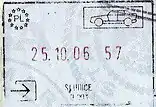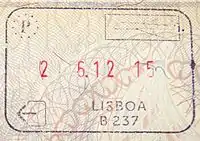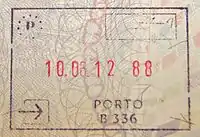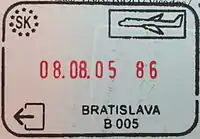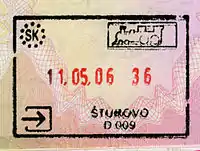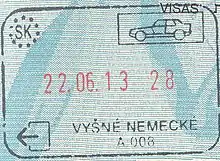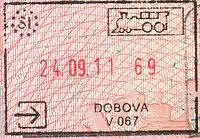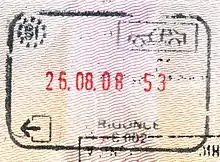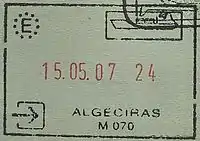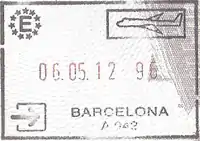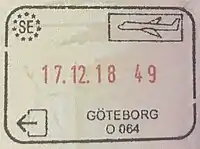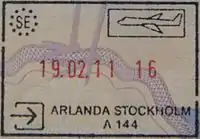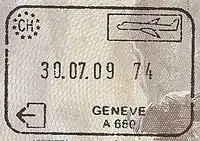Passport stamp
A passport stamp is an inked impression in a passport typically made by rubber stamp upon entering or exiting a territory.

Passport stamps may occasionally take the form of sticker stamps, such as entry stamps from Japan. Depending on nationality, a visitor may not receive a stamp at all (unless specifically requested), such as an EU or EFTA citizen travelling to an EU or EFTA country, Albania,[1] or North Macedonia.[2] Most countries issue exit stamps in addition to entry stamps. A few countries issue only entry stamps, including Canada, El Salvador, Ireland, Mexico, New Zealand, Singapore, the United Kingdom and the United States.
Australia, Hong Kong, Israel, Macau and South Korea do not stamp passports upon entry nor exit, but issue landing slips instead. Visas may also take the form of passport stamps.
Use
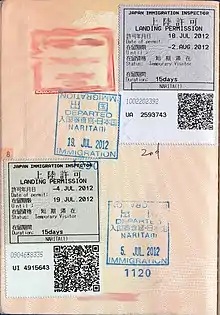
Border control officials often place stamps in passports as part of their immigration control or customs procedures. This endorsement can serve many different purposes. In the United Kingdom the immigration stamp in the passport includes the formal "leave to enter" granted on entry to the country to a person who is subject to immigration control. Alternatively, the stamps activate and/or acknowledge the continuing leave conferred by the individual's entry clearance. Other authorities, such as those in Schengen member states, simply stamp a passport with a date stamp that does not indicate any duration and this stamp is taken to mean either that the person is deemed to have permission to remain for three months or an alternative period as shown on their visa. In Japan, the passport entry sticker also contains a QR code that allows the immigration official to electronically collect information related to that entry.
Most countries have different stamps for arrivals and departures to make it easier for officers to quickly identify the movements of the person concerned. The colour of the ink or the style of stamp may also provide such information.
In many cases passengers on cruise ships do not receive passport stamps because the entire vessel has been cleared into port. It is often possible to get a souvenir stamp, although this requires finding the immigration office by the dock. In many cases officials are used to such requests and will cooperate.[3][4] Also, as noted below, some of the smallest European countries will give a stamp on request, either at their border or tourist office charging, at most, a nominal fee.
Overview of passport stamps of countries
Armenia
_entry_stamp_01.png.webp)
_exit_stamp.png.webp)
Bangladesh

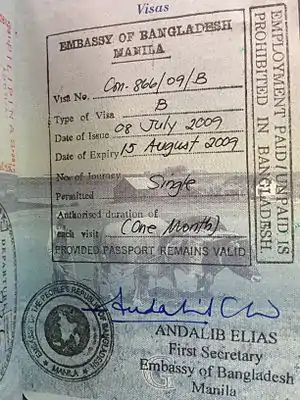
Bangladesh stamps all travellers' passports upon both entry and exit. Handwritten scroll numbers on the stamp make it easier to track a person's complete journey – a Bangladeshi leaving Bangladesh would receive a scroll number upon exit; upon entry, the scroll number would be used to access related journey information of the traveller. The same is the case for foreigners, except that the scroll number is given on entry and then used on exit.
The stamps are always in black except the date, which is in red. The stamps feature an arrow at the top left corner, pointing left to denote departure, or pointing right for arrival together with a cartoon of the mode of transport at the top right corner.
Entry stamps are rectangular and exit stamps are oval, exit make it visually easier to trace movements.
Bahrain
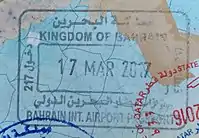
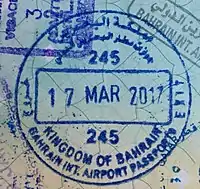
Cambodia
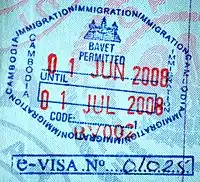
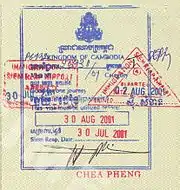
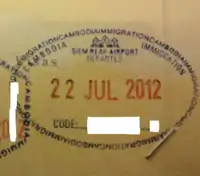
China
 Entry stamp at Chengdu Shuangliu International Airport in an old People's Republic of China passport.
Entry stamp at Chengdu Shuangliu International Airport in an old People's Republic of China passport. Entry and exit stamps at Dongguan in an old People's Republic of China passport.
Entry and exit stamps at Dongguan in an old People's Republic of China passport.
(Noted that there were no English on stamps.)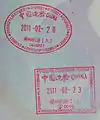 Entry and exit stamps at Fuzhou Changle International Airport in an old Thai passport.
Entry and exit stamps at Fuzhou Changle International Airport in an old Thai passport. Entry and exit stamps at Guangzhou Baiyun International Airport in a Thai passport.
Entry and exit stamps at Guangzhou Baiyun International Airport in a Thai passport. Entry and exit stamps at Shanghai Pudong International Airport on an Italian passport.
Entry and exit stamps at Shanghai Pudong International Airport on an Italian passport. Entry and exit stamps at Beijing Capital International Airport in a Republic of Korea passport.
Entry and exit stamps at Beijing Capital International Airport in a Republic of Korea passport.
Georgia
_entry_stamp.png.webp)
_exit_stamp.png.webp)
_Entry_and_Exit_Stamp.jpg.webp)
Hong Kong
The Hong Kong Immigration Department used to stamp the passports of visitors entering and leaving Hong Kong (residents using their Hong Kong Identity Card did not receive a stamp). Just prior to and after the 1997 transfer of sovereignty from the UK to the People's Republic of China, arrival and departure stamps were identical at all ports of entry.
For the next 15 years or so, the ink colour of the stamp differentiated the administrative division of the point of entry:
- Stamps issued within New Territories (Sha Tau Kok Control Point, Man Kam To Control Point, Lo Wu Control Point, Lok Ma Chau Control Point, Lok Ma Chau Spur Line Control Point and Shenzhen Bay Control Point by land, Tuen Mun Ferry Terminal Control Point by sea) are in red ink.
- Stamps issued within Kowloon (Hung Hom Control Point by trains, Ocean Terminal Control Point and China Ferry Terminal Control Point by sea) are in green ink.
- Stamps issued within Hong Kong Island (Hong Kong-Macau Ferry Terminal Control Point, by either sea or air) are in purple ink.
- Stamps issued within Islands District (Hong Kong International Airport Control Point by air) are in black ink.
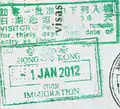 Entry stamp at Hong Kong China Ferry Terminal in a Thai passport.
Entry stamp at Hong Kong China Ferry Terminal in a Thai passport.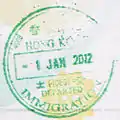 Exit stamp at Hong Kong China Ferry Terminal in a Thai passport.
Exit stamp at Hong Kong China Ferry Terminal in a Thai passport. Entry and exit stamps at Hong Kong International Airport and the Hong Kong – Macau Ferry Terminal in an Italian passport.
Entry and exit stamps at Hong Kong International Airport and the Hong Kong – Macau Ferry Terminal in an Italian passport. Old style entry and exit stamps at Hong Kong International Airport and Lo Wu Control Point in an old Thai passport.
Old style entry and exit stamps at Hong Kong International Airport and Lo Wu Control Point in an old Thai passport.
(Noted that there were no Bauhinia on stamps and exit stamps were in oval.)
India
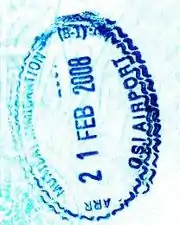
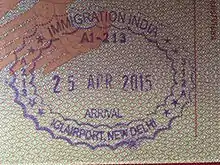
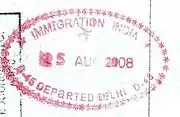
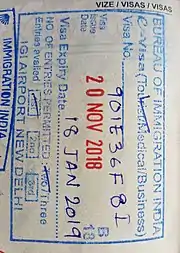
India uses the differentiation in passport stamp colours – entry in blue, exit in red – to quickly trace a passenger's movements. The stamp can be rectangular, circular or oval.
Indonesia

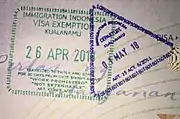
Iran
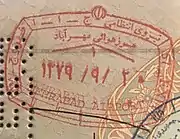
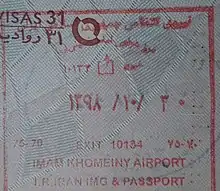
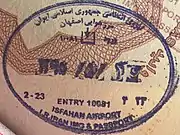
Iran uses an oval shaped stamp with blue ink for entry and a square shaped stamp with red ink for exit.
Iraq
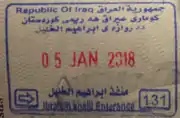
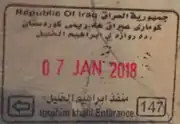
.jpg.webp)
Iraq passport stamps differ depending upon whether the checkpoint is located in Iraqi Kurdistan, or the rest of Iraq.
Israel
Traveling with passports containing Israeli entry/exit stamps to certain Arab nations may lead to a denial of entry, because of the Arab League boycott of Israel. Since January 2013, Israel no longer stamps foreign passports at Ben Gurion Airport, giving passengers a piece of paper instead. Passports are still (as of February 2013) stamped at Erez Crossing when traveling into and out of Gaza. Also, the passports are still stamped (as of February 2014) at the land borders of Jordan River Crossing and Yitzhak Rabin Crossing with Jordan and Taba Border Crossing with Egypt.

 An Israeli entry stamp in a U.S. passport at Ben Gurion Airport.
An Israeli entry stamp in a U.S. passport at Ben Gurion Airport..jpg.webp) Entry and exit stamps in a German passport at Ben Gurion Airport (entry: right; exit: left).
Entry and exit stamps in a German passport at Ben Gurion Airport (entry: right; exit: left). An Israeli entry paper at Ben Gurion Airport.
An Israeli entry paper at Ben Gurion Airport. An Israeli exit paper at Ben Gurion Airport.
An Israeli exit paper at Ben Gurion Airport.
Japan
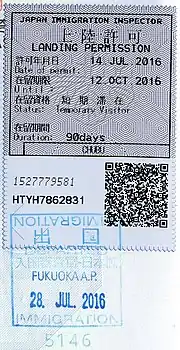
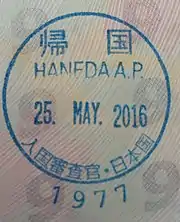

Jordan
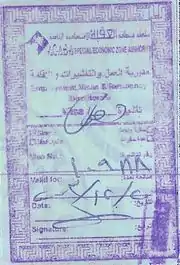
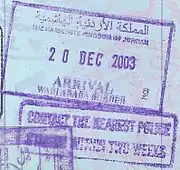
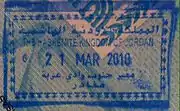
Laos
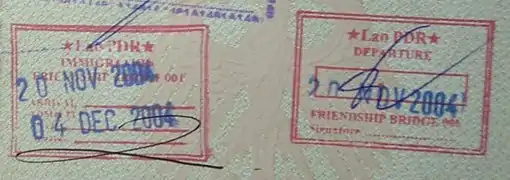
Macau
Immigration stamps applied by Macau's immigration service under Portuguese administration had slightly different borders depending on whether the person arrived by land, sea, or air. After the transfer of sovereignty from Portugal to China in 1999, passport stamps naming the points of entry and departure were introduced, but all in the same ink color. Beginning of 9 July 2013, the Public Security Police Force of Macau no longer stamps passport and instead, visitors will receive a printed arrival card instead.[5]
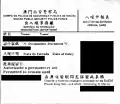 Arrival Card replacing existent passport stamps.
Arrival Card replacing existent passport stamps. Former entry stamp at Macau International Airport.
Former entry stamp at Macau International Airport.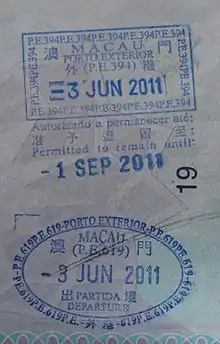 Former entry and exit stamps at Outer Harbour Ferry Terminal, Macau.
Former entry and exit stamps at Outer Harbour Ferry Terminal, Macau. Former entry and exit stamps at Taipa Temporary Ferry Terminal in a Philippine passport.
Former entry and exit stamps at Taipa Temporary Ferry Terminal in a Philippine passport.
Malaysia
Malaysian immigration authorities apply stamps for both entry and exit in all foreign passports and non-biometric Malaysian passports without in-built microchips. Biometric Malaysian passports are usually not stamped as all movements in and out of the country are recorded electronically in the microchip.
Malaysian entry stamps for non-citizens and non-residents are rectangular and stamped in blue or black. They bear the date of entry, point of entry and terms of entry. Entry stamps for residents are also stamped in blue ink but have an oval shape and bear the date and point of entry. Exit stamps are triangular and stamped in red. They bear the date and point of departure.
A peculiarity is the autonomy of the Malaysian states of Sabah and Sarawak in immigration affairs. This is attributed to the history of the federation of Malaysia, whereby in 1963, Malaya, North Borneo, Sarawak and Singapore merged to form Malaysia, with the three latter pre-merger entities granted partial autonomy. (Singapore eventually was expelled from the union.) Foreign visitors who travel to the two states from Peninsular Malaysia are required to fill in immigration forms and get new stamps on their passports. There is also immigration control for travel between Sabah and Sarawak. Previously, Malaysian citizens from the Peninsular were required to present their passports and have them stamped as well; while they are currently still subjected to immigration control, passports are no longer required for social visits not more than three months.
Between 1998 and 2011, foreign visitors who entered Malaysia via train from Singapore were cleared electronically without their passports being stamped.[6] The change was due to the dispute between Malaysia and Singapore regarding Malaysian-owned railway land in Singapore. The Malaysian railway operator, Keretapi Tanah Melayu (KTM) had its intercity rail southern terminus at Tanjong Pagar railway station in downtown Singapore, which also housed the border controls of both Malaysia and Singapore for rail passengers before 1998. In 1998, Singapore moved its immigration checkpoint northward to Woodlands Train Checkpoint near the actual Malaysia-Singapore border but Malaysia refused to move its checkpoint, resulting in the anomaly that passengers travelling towards Malaysia were granted entry to Malaysia before passing through Singapore exit controls. Instead of passport stamps, foreign visitors were given disembarkation cards stamped with "KTM Tg Pagar, Singapura" and the date of entry, which would be collected upon departure from Malaysia and a handwritten note indicating the entry would be endorsed in the passport along with the exit stamp. Passengers travelling to Singapore were not affected as Malaysian exit controls were carried out on board trains at the Johor Bahru railway station, where immigration officers endorsed passports by stamping or handwriting. The anomaly was resolved on 1 July 2011, when Tanjong Pagar railway station was closed and Woodlands Train Checkpoint became the railway terminus in Singapore with co-location of border control facilities of both countries. Foreign visitors entering Malaysia by rail have their passports checked and stamped by Malaysian immigration officers at Woodlands Train Checkpoint after clearing Singapore exit controls.

 Entry stamp into Sarawak at Merapok checkpoint on the Sabah-Sarawak border, with written date for limit of stay.
Entry stamp into Sarawak at Merapok checkpoint on the Sabah-Sarawak border, with written date for limit of stay. Entry stamp for citizens before biometric passports were introduced. This is at former Subang International Airport.
Entry stamp for citizens before biometric passports were introduced. This is at former Subang International Airport. Standard exit stamp, at Johor Bahru exit to Singapore (pre-2008). Post-2008 stamps have "Bangunan Sultan Iskandar" in place of "Johor Bahru" when travelling by road.
Standard exit stamp, at Johor Bahru exit to Singapore (pre-2008). Post-2008 stamps have "Bangunan Sultan Iskandar" in place of "Johor Bahru" when travelling by road.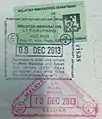 Entry and exit stamps at Penang International Airport in a Thai passport
Entry and exit stamps at Penang International Airport in a Thai passport Entry and exit stamps Penang International Airport in an American passport
Entry and exit stamps Penang International Airport in an American passport Entry and exit stamps (Kuala Lumpur), as well as a separate entry stamp to Sabah
Entry and exit stamps (Kuala Lumpur), as well as a separate entry stamp to Sabah
Myanmar
With the introduction of e-visas, entry stamps into Myanmar at the airports of Yangon, Mandalay and Naypyidaw, the only three entry checkpoints where e-visas are allowed, have been modified to indicate such method of entry.
 Entry (left) and exit stamps issued at the Yangon International Airport. The entry stamp is for people using e-visas. E-visas are issued via letter prior to arrival and are shown to the immigration officer, and not stuck to passports like conventional visas.
Entry (left) and exit stamps issued at the Yangon International Airport. The entry stamp is for people using e-visas. E-visas are issued via letter prior to arrival and are shown to the immigration officer, and not stuck to passports like conventional visas.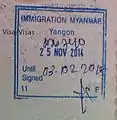 Entry stamp at Yangon International Airport for entries using conventional visas. The visas are stickers stuck on another page of the passport.
Entry stamp at Yangon International Airport for entries using conventional visas. The visas are stickers stuck on another page of the passport.
 Exit stamp issued at Tachileik when leaving on the Friendship Bridge. Note that the stamp specifically names Mae Sai as destination.
Exit stamp issued at Tachileik when leaving on the Friendship Bridge. Note that the stamp specifically names Mae Sai as destination.
Nepal
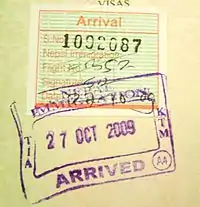
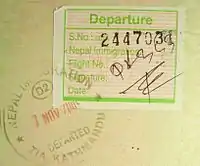
Nepal is one of the few countries which use sticker stamps. Nepalese immigration authorities use separate Arrival and Departure stickers for entry and exit on all types of passports.
Oman
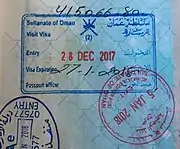
As of December 2017, one who obtains a visa on arrival does not get a round entry stamp. Instead they get a rectangular, blue stamp that states the entry date and validity of the visa. This seems to, however, be the case only when arriving at Muscat International Airport. At land borders, the rectangular stamp is accompanied by a round, blue entry stamp. A round, red exit stamp is issued at all points of exit.
Pakistan
A circular entry stamp in black ink is applied to passports of all nationalities at the time of entry. A triangular multi colored entry stamp was used until 2015. An exit stamp is also applied to all passports when leaving the country. Exit stamp in use at present is rectangular in shape and black in color.
 Old Multi colored entry stamp at Karachi airport.
Old Multi colored entry stamp at Karachi airport.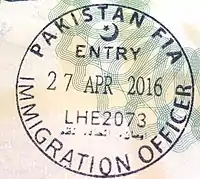 Circular entry stamp presently used at Lahore airport.
Circular entry stamp presently used at Lahore airport.
Philippines
At airports, red ink is used for arrivals/entry and green is used for departure/exit. As a general rule, passports of all travellers regardless of their nationality (including Filipino passport holders), need to be stamped at both entry and exit points. The attending officer also writes down the flight number and stamps the passenger's boarding pass upon departure with the same stamp that is used for departure. The shape and/or designs of the stamps are changed every five to six years.
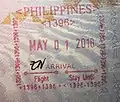 Arrival Entry Stamp in a Philippine Passport
Arrival Entry Stamp in a Philippine Passport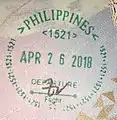 Departure Exit Stamp in a Philippine Passport
Departure Exit Stamp in a Philippine Passport
Saudi Arabia
Saudi entry stamps are in black or blue ink. Entry stamps are in oval shape while exit stamps are rounded rectangular. All dates written on the stamps are in the Hijra calendar, and it is written in Arabic. There is no English on the stamps, except for the "EXIT" or "ENTRY" written on the stamps.
 Entry stamp in Jeddah on a Malaysian passport.
Entry stamp in Jeddah on a Malaysian passport.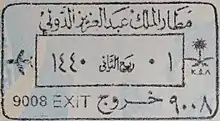 Exit stamp in Jeddah on a Malaysian passport.
Exit stamp in Jeddah on a Malaysian passport. Passport stamps from the King Abdulaziz International Airport in Jeddah on a Philippine passport.
Passport stamps from the King Abdulaziz International Airport in Jeddah on a Philippine passport.
Singapore
Singapore entry stamps are in blue or black and either rectangular for those entitled to 14 days, rounded rectangular for those entitled to 30 days stay, or hexagonal for those entitled to 90 day stay. Exit stamps are circular and in green. Both depict the date of entry/exit and entry stamps also state the terms of entry and permitted duration of stay.
Both entry and exit stamps do not name the point of entry/exit but indicate them by the use of letters of the alphabet – "A" is used for entry by air, namely through Changi Airport or Seletar Airport; "S" by sea though the Singapore Cruiseship Terminal or Tanah Merah Ferry Terminal; "T" by land via the Tuas Checkpoint; and "W" by land via the Woodlands Checkpoint. The entry stamp has the letter running along the border of the stamp together with a code number while the exit stamp has a single letter marked in the center of the stamp. From 22 April 2019, foreign travellers no longer get their passports stamped when they depart from Singapore.[7]
 Entry stamp at Changi Airport in an old Thai Passport
Entry stamp at Changi Airport in an old Thai Passport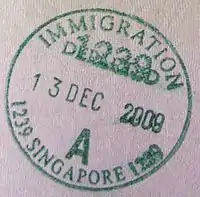 Exit stamp at Changi Airport
Exit stamp at Changi Airport Entry and exit by sea, at the Singapore Cruise Center.
Entry and exit by sea, at the Singapore Cruise Center.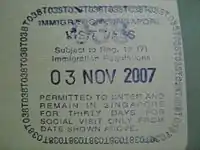 Entry stamp into Singapore via Tuas Checkpoint in a Malaysian Passport
Entry stamp into Singapore via Tuas Checkpoint in a Malaysian Passport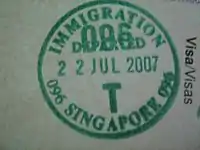 Exit stamp in a Malaysian Passport for leaving Singapore to Tanjung Kupang in Johor, Malaysia, via the Tuas Checkpoint
Exit stamp in a Malaysian Passport for leaving Singapore to Tanjung Kupang in Johor, Malaysia, via the Tuas Checkpoint Entry stamp at Singapore via Woodlands Train Checkpoint in a Malaysian Passport
Entry stamp at Singapore via Woodlands Train Checkpoint in a Malaysian Passport Exit stamp in a Malaysian Passport for leaving Singapore to Johor Bahru via Woodlands Train Checkpoint
Exit stamp in a Malaysian Passport for leaving Singapore to Johor Bahru via Woodlands Train Checkpoint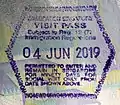 Entry stamp at Singapore via Woodlands Train Checkpoint
Entry stamp at Singapore via Woodlands Train Checkpoint
Sri Lanka
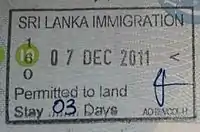 Entry stamp at Bandaranaike International Airport
Entry stamp at Bandaranaike International Airport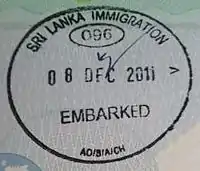 Exit stamp at Bandaranaike International Airport
Exit stamp at Bandaranaike International Airport
South Korea
Entry stamp is square shaped and stamped with magenta ink. Exit stamp is round shaped and stamped with cyan ink. Exit stamp is omitted to every passenger since 1 November 2016. Entry stamp is only omitted to Republic of Korea travel document holder since 10 February 2011. Beginning January 2018, landing slips are issued to visitors on arrival in South Korea instead of passport stamps, and on departure from South Korea no slips or passport stamps are issued (being unable to present the landing slip on departure does not affect a traveller's ability to clear immigration). As of January 2020, entry stamp is still issued in other entry points besides Incheon International Airport and Gimpo International Airport.
 Entry and exit stamps at Incheon International Airport, depicting aircraft.
Entry and exit stamps at Incheon International Airport, depicting aircraft.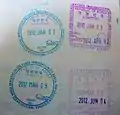 Entry and exit stamps at Busan Port, depicting sea vessels.
Entry and exit stamps at Busan Port, depicting sea vessels.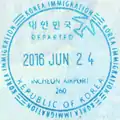 An exit stamp at Incheon International Airport in a Republic of Korea passport.
An exit stamp at Incheon International Airport in a Republic of Korea passport.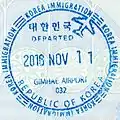 An exit stamp at Gimhae International Airport in a Republic of Korea passport (given upon request).
An exit stamp at Gimhae International Airport in a Republic of Korea passport (given upon request).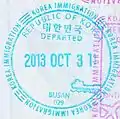 An exit stamp at Port of Busan in a Republic of Korea passport.
An exit stamp at Port of Busan in a Republic of Korea passport.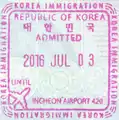 An entry stamp at Incheon International Airport in a Republic of Korea passport (given upon request).
An entry stamp at Incheon International Airport in a Republic of Korea passport (given upon request).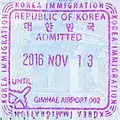 An entry stamp at Gimhae International Airport in a Republic of Korea passport (given upon request).
An entry stamp at Gimhae International Airport in a Republic of Korea passport (given upon request).
Taiwan
A set of new passport stamps was used from February 10, 2013. The Chinese characters on the new stamps are inscribed by Yang-Zi Dong, a famous calligrapher in Taiwan.
 Entry and exit stamps at Kaohsiung International Airport in a U.S. passport.
Entry and exit stamps at Kaohsiung International Airport in a U.S. passport.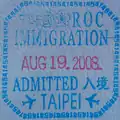 Entry stamp in a passport at Taiwan Taoyuan International Airport, Taiwan.(R.O.C.)
Entry stamp in a passport at Taiwan Taoyuan International Airport, Taiwan.(R.O.C.)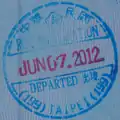 Exit stamp in a passport at Taiwan Taoyuan International Airport, Taiwan.(R.O.C.)
Exit stamp in a passport at Taiwan Taoyuan International Airport, Taiwan.(R.O.C.)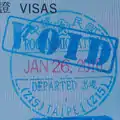 A void exit stamp in a passport at Taiwan Taoyuan International Airport, Taiwan.(R.O.C.)
A void exit stamp in a passport at Taiwan Taoyuan International Airport, Taiwan.(R.O.C.)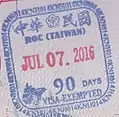 An entry stamp with a marker indicating arrival by ship, rather than by plane.
An entry stamp with a marker indicating arrival by ship, rather than by plane.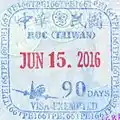 An entry stamp at Taoyuan International Airport in a Republic of Korea passport.
An entry stamp at Taoyuan International Airport in a Republic of Korea passport.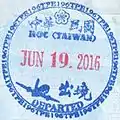 An exit stamp at Taoyuan International Airport in a Republic of Korea passport.
An exit stamp at Taoyuan International Airport in a Republic of Korea passport.
Thailand
Immigration stamps applied by Thailand's Immigration Bureau are stamped on all passports upon arrival at or departure from Thailand. All stamps are made in blue ink. Entry stamps are rectangular and exit stamps are triangular. Stamps bear the date and point of entry/exit, as well as a letter running along the border of the stamp accompanying a code number. Entry stamps for foreigners also state expiry date.
52 Automatic passport check machines were installed at Suvarnabhumi Airport and Don Mueang International Airport to scan certain Thai, Singaporean and Hong Kong passports.[8] For Singaporean and Hong Kong passports, once the machine clears your immigration, you move forward to an immigration officer who would inspect your departure card and passport to ensure that the details match each other. The passport is then stamped and your immigration card is collected by the immigration officer.
 Entry and exit stamps at Betong land border crossing on Malaysia–Thailand border.
Entry and exit stamps at Betong land border crossing on Malaysia–Thailand border. Entry and exit stamps at Don Mueang International Airport in an old Thai passport.
Entry and exit stamps at Don Mueang International Airport in an old Thai passport. Entry stamp at Thai–Lao Friendship Bridge in a Thai passport.
Entry stamp at Thai–Lao Friendship Bridge in a Thai passport. Exit stamp at Thai–Lao Friendship Bridge in a Thai passport.
Exit stamp at Thai–Lao Friendship Bridge in a Thai passport. Entry and exit stamps at Phuket International Airport.
Entry and exit stamps at Phuket International Airport. Entry stamp at Sadao land border crossing on Malaysia–Thailand border.
Entry stamp at Sadao land border crossing on Malaysia–Thailand border. Exit stamp at Sadao land border crossing on Malaysia–Thailand border.
Exit stamp at Sadao land border crossing on Malaysia–Thailand border.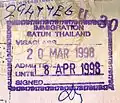 Entry stamp at Satun land border crossing on Malaysia–Thailand border.
Entry stamp at Satun land border crossing on Malaysia–Thailand border. Exit stamp at Satun land border crossing on Malaysia–Thailand border.
Exit stamp at Satun land border crossing on Malaysia–Thailand border. Entry and exit stamps at Suvarnabhumi Airport.
Entry and exit stamps at Suvarnabhumi Airport.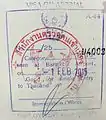 Visa on arrival stamp on a Taiwanese passport.
Visa on arrival stamp on a Taiwanese passport.
Timor-Leste
Timor-Leste uses a full page blue stamp along with a red date entry stamp on entry. Exit stamps are a black oval.
 Passport stamp of the country Timor-Leste
Passport stamp of the country Timor-Leste
United Arab Emirates
The UAE use oval blue stamps on entry, along with a smaller blue rectangular stamp showing the valid length of stay. Exit stamps are a green oval.
 Entry and exit stamps at Abu Dhabi International Airport.
Entry and exit stamps at Abu Dhabi International Airport.
Vietnam
Vietnam passport stamps are rectangular and name the point of entry, date of entry and whether the person is exiting or entering the country by using an arrow out of or into a box similar to the Schengen passport stamps. Mode of entry is indicated by an icon and also differentiated by the colour of the stamp – blue for air, red for land crossings. The permitted length of stay is printed with a separate stamp and the final date handwritten.
 Exit stamp from the road border crossing at Moc Bai.
Exit stamp from the road border crossing at Moc Bai. Entry and exit stamps at Noi Bai International Airport, Hanoi.
Entry and exit stamps at Noi Bai International Airport, Hanoi.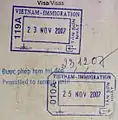 Entry and exit stamps at Tan Son Nhat International Airport, Ho Chi Minh City.
Entry and exit stamps at Tan Son Nhat International Airport, Ho Chi Minh City.
Botswana
 Botswana entry stamp in Tlokweng from South African Republic (Kopfonten) in an Israeli passport
Botswana entry stamp in Tlokweng from South African Republic (Kopfonten) in an Israeli passport Botswana exit stamp in Kazungula Ferry to Zambia (Kazungula) in an Israeli passport
Botswana exit stamp in Kazungula Ferry to Zambia (Kazungula) in an Israeli passport
Burkina Faso
 Burkina Faso entry stamp in Ouagadougou airport in an Israeli passport
Burkina Faso entry stamp in Ouagadougou airport in an Israeli passport Burkina Faso exit stamp in Ouagadougou airport in an Israeli passport
Burkina Faso exit stamp in Ouagadougou airport in an Israeli passport
Burundi
 Burundi entry stamp in Kanyaru from Rwanda (Akanyaru) in an Israeli passport
Burundi entry stamp in Kanyaru from Rwanda (Akanyaru) in an Israeli passport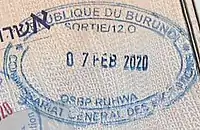 Burundi exit stamp in Ruhwa to Rwanda (Ruhwa) in an Israeli passport
Burundi exit stamp in Ruhwa to Rwanda (Ruhwa) in an Israeli passport
Cameroon
 Cameroon entry stamp in Kye-Ossi from Gabon (Bitam) in an Israeli passport
Cameroon entry stamp in Kye-Ossi from Gabon (Bitam) in an Israeli passport Cameroon exit stamp in Yaounde airport in an Israeli passport
Cameroon exit stamp in Yaounde airport in an Israeli passport
Egypt
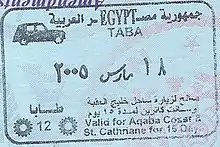
 Egyptian visa with entry and exit stamps from Cairo International Airport.
Egyptian visa with entry and exit stamps from Cairo International Airport.
Eritrea
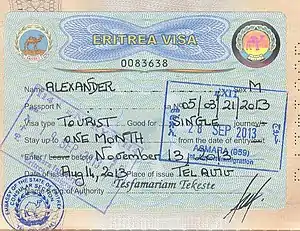 Eritrean entry and exit stamps in Asmara airport on Eritrean visa in an Israeli passport
Eritrean entry and exit stamps in Asmara airport on Eritrean visa in an Israeli passport
Eswatini
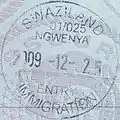 Passport stamp from Swaziland
Passport stamp from Swaziland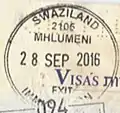 Eswatini (Swaziland) exit stamp in Mhlumeni to Mozambique (Goba) in an Israeli passport
Eswatini (Swaziland) exit stamp in Mhlumeni to Mozambique (Goba) in an Israeli passport
Ethiopia
 Ethiopia entry stamp in Addis Ababa airport in an Israeli passport
Ethiopia entry stamp in Addis Ababa airport in an Israeli passport Ethiopia exit stamp in Addis Ababa airport in an Israeli passport
Ethiopia exit stamp in Addis Ababa airport in an Israeli passport
French overseas departments (Mayotte and Réunion)
When arriving in and departing from the French overseas departments of Mayotte and Réunion, French Border Police officers stamp travellers' travel documents according to the following rules:[9][10]
| Persons whose travel documents are to be stamped | Persons whose travel documents are not to be stamped |
|---|---|
|
|
Travellers flying directly from metropolitan France to Mayotte or Réunion only undergo border checks by the French Border Police at the departure airport in metropolitan France and not on arrival at Dzaoudzi–Pamandzi International Airport in Mayotte or Roland Garros Airport in Réunion. However, as third-country nationals (who do not benefit from one of the exemptions in the right-hand column above) are required to receive a passport stamp, the French Border Police will give them an information sheet when they leave metropolitan France informing them that they should present themselves to the French Border Police at the arrival airport to receive a passport stamp. On the other hand, travellers flying directly from Mayotte or Réunion to metropolitan France undergo border checks by the French Border Police both on departure and on arrival, when their travel documents will be stamped accordingly.[11]
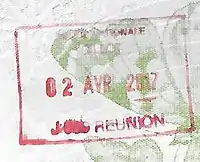 Entry stamp in Réunion
Entry stamp in Réunion
Gabon
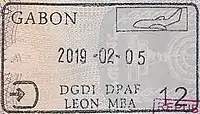 Gabon entry stamp in Libreville airport in an Israeli passport
Gabon entry stamp in Libreville airport in an Israeli passport Gabon exit stamp in Bitam (Meyo Kye) to Cameroon (Kye-Ossi) in an Israeli passport
Gabon exit stamp in Bitam (Meyo Kye) to Cameroon (Kye-Ossi) in an Israeli passport
Gambia
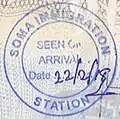 Gambia entry stamp in Soma from Senegal (Digante) in an Israeli passport
Gambia entry stamp in Soma from Senegal (Digante) in an Israeli passport
Ghana
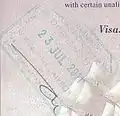 An entry stamp to Ghana as seen in a U.S. Passport.
An entry stamp to Ghana as seen in a U.S. Passport. A Ghana exit stamp
A Ghana exit stamp
Guinea Bissau
 Guinea-Bissau entry stamp in Bissau airport in an Israeli passport
Guinea-Bissau entry stamp in Bissau airport in an Israeli passport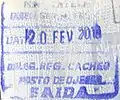 Guinea-Bissau exit stamp in Jeque to Senegal (Mpak) in an Israeli passport
Guinea-Bissau exit stamp in Jeque to Senegal (Mpak) in an Israeli passport
Kenya
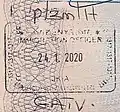 Kenya entry stamp in Nairobi airport in an Israeli passport
Kenya entry stamp in Nairobi airport in an Israeli passport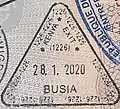 Kenya exit stamp in Busia to Uganda (Busia) in an Israeli passport
Kenya exit stamp in Busia to Uganda (Busia) in an Israeli passport
Malawi
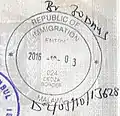 Malawi entry stamp in Dedza from Calomue (Mozambique) in an Israeli passport
Malawi entry stamp in Dedza from Calomue (Mozambique) in an Israeli passport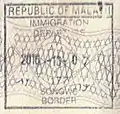 Malawi exit stamp in Songwe to Tanzania (Kasumulu) in an Israeli passport
Malawi exit stamp in Songwe to Tanzania (Kasumulu) in an Israeli passport
Morocco
 Passport entry stamp from the port of Tangier, Tanger in French. Shown in a Canadian Passport.
Passport entry stamp from the port of Tangier, Tanger in French. Shown in a Canadian Passport. Exit stamp at the border crossing between Beni-Anzar and Melilla, in a US passport.
Exit stamp at the border crossing between Beni-Anzar and Melilla, in a US passport.
Mozambique
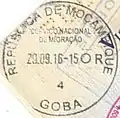 Mozambique entry stamp in Goba from Eswatini (Mhlumeni) in an Israeli passport
Mozambique entry stamp in Goba from Eswatini (Mhlumeni) in an Israeli passport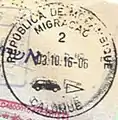 Mozambique exit stamp in Calomue to Malawi (Dedza) in an Israeli passport
Mozambique exit stamp in Calomue to Malawi (Dedza) in an Israeli passport
Nigeria
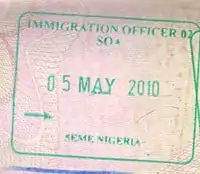 An entry stamp to Nigeria as seen in a Nigerian Passport at Seme Border.
An entry stamp to Nigeria as seen in a Nigerian Passport at Seme Border.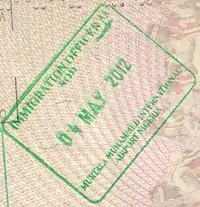 A Nigerian exit stamp as seen in a Nigerian Passport at Lagos.
A Nigerian exit stamp as seen in a Nigerian Passport at Lagos.
Rwanda
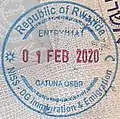 Rwanda entry stamp in Gatuna from Uganda (Katuna) in an Israeli passport
Rwanda entry stamp in Gatuna from Uganda (Katuna) in an Israeli passport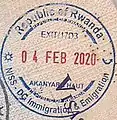 Rwanda exit stamp in Akanyaru to Burundi (Kanyaru) in an Israeli passport
Rwanda exit stamp in Akanyaru to Burundi (Kanyaru) in an Israeli passport
Senegal
 Senegal entry stamp in Keur Ayib from Gambia (Farafenni) in an Israeli passport
Senegal entry stamp in Keur Ayib from Gambia (Farafenni) in an Israeli passport Senegal exit stamp in Dakar Airport in an Israeli passport
Senegal exit stamp in Dakar Airport in an Israeli passport
South Africa
 A South African entry stamp as seen in a Nigerian Passport issued for study purposes.
A South African entry stamp as seen in a Nigerian Passport issued for study purposes. An entry stamp to South Africa issued for vacation purposes.
An entry stamp to South Africa issued for vacation purposes.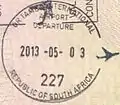 A South African exit stamp at Johannesburg-OR Tambo
A South African exit stamp at Johannesburg-OR Tambo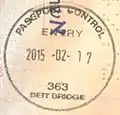 South African entry stamp in Beit Bridge from Zimbabwe (Beit Bridge) in an Israeli passport
South African entry stamp in Beit Bridge from Zimbabwe (Beit Bridge) in an Israeli passport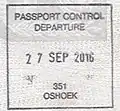 South African exit stamp in Oshoek to Eswatini (Ngwenya) in an Israeli passport
South African exit stamp in Oshoek to Eswatini (Ngwenya) in an Israeli passport
Tanzania
 Tanzania entry stamp in Kasumulu from Malawi (Songwe) in an Israeli passport
Tanzania entry stamp in Kasumulu from Malawi (Songwe) in an Israeli passport Tanzania exit stamp in Dar es Salaam airport in an Israeli passport
Tanzania exit stamp in Dar es Salaam airport in an Israeli passport Zanzibar entry stamp in Zanzibar seaport in an Israeli passport
Zanzibar entry stamp in Zanzibar seaport in an Israeli passport
Tunisia
Tunisia stamps passports on entry and exit. In the photo below, the red stamp indicates the entry date, while the black stamp indicates the exit date.[12]
 Entry and exit stamps at Tunis-Carthage Airport.
Entry and exit stamps at Tunis-Carthage Airport.
Uganda
 Uganda entry stamp in Busia from Kenya (Busia) in an Israeli passport
Uganda entry stamp in Busia from Kenya (Busia) in an Israeli passport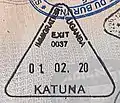 Uganda exit stamp in Katuna to Rwanda (Gatuna) in an Israeli passport
Uganda exit stamp in Katuna to Rwanda (Gatuna) in an Israeli passport
Zambia
 Zambia entry stamp in Kazungula from Botswana (Kazungula) in an Israeli passport
Zambia entry stamp in Kazungula from Botswana (Kazungula) in an Israeli passport Zambia exit stamp in Victoria Falls to Zimbabwe (Victoria Falls) in an Israeli passport
Zambia exit stamp in Victoria Falls to Zimbabwe (Victoria Falls) in an Israeli passport
Zimbabwe
 Zimbabwe entry stamp in Victoria Falls from Zambia (Victoria Falls) in an Israeli passport
Zimbabwe entry stamp in Victoria Falls from Zambia (Victoria Falls) in an Israeli passport Zimbabwe exit stamp in Beit Bridge to South African Republic (Beit Bridge) in an Israeli passport
Zimbabwe exit stamp in Beit Bridge to South African Republic (Beit Bridge) in an Israeli passport
Schengen Area
All 26 European countries within the Schengen Area have entry and exit stamps of a uniform design. As of April 2016, at a national level, 11 Schengen countries (Estonia, Finland, Greece, Hungary, Latvia, Lithuania, Malta, Poland, Portugal, Slovakia and Spain)[13][14][15][16][17][18][19] have developed computer databases recording entries and exits of third-country nationals (i.e. travellers who are not EU, EEA or Swiss citizens) at external border crossing points. However, on a Schengen-wide level, there is no centralised computer database that tracks entries and exits at all of the external border crossing points of the 26 Schengen countries, nor are entry and exit records from national databases shared between countries.[20] As a result, law enforcement officials continue to rely on checking passport stamps as the primary way to check that travellers who do not have the right of free movement have not exceeded their length of permitted stay in the Schengen Area.
Regulation (EU) 2017/2226 envisages the establishment of an Entry-Exit System (EES) which will record third-country nationals' entries and exits when they cross the external borders of the Schengen Area in a central database, replacing passport stamps.[21] As of April 2020, EES is scheduled to enter into operation sometime in the first quarter of 2022.[22]
There are no systematic immigration checks when travelling between Schengen countries (i.e. crossing the internal borders of the Schengen Area). Passport stamps are never issued when travelling between Schengen countries, even when immigration checks between Schengen countries are temporarily re-introduced.[23]
When travelling to/from a non-Schengen country (i.e. crossing the external borders of the Schengen Area), the rules on stamping travel documents are as follows:[24]
| Persons whose travel documents are to be stamped | Persons whose travel documents are not to be stamped |
|---|---|
|
|
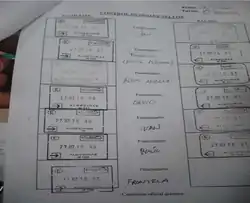
Border officials are required, by law, to stamp the travel documents of third country nationals who do not qualify for one of the exemptions listed in the right hand column, even when border controls have been relaxed. Exceptionally, if stamping a person's travel document would cause serious difficulties (such as political persecution), border officials can instead issue a sheet of paper detailing the person's name, travel document number and entry date and location.[24] However, in practice, border officials do not always stamp the travel documents of travellers as legally required.[28][29] If a person who should have received an entry stamp cannot show one either upon request by a law enforcement officer or upon leaving the Schengen Area to a border official, the officer can presume that the person has been staying illegally in the Schengen Area and can expel him/her, unless the person can demonstrate using credible evidence (such as transport tickets and accommodation receipts) that he/she has not exceeded his/her permitted length of stay in the Schengen Area.[30]
Also, whilst by law persons enjoying the right of freedom of movement are not to receive a passport stamp, in practice, upon request, a stamp may be given – see the gallery below for an example of an entry stamp being issued upon request by an EU citizen. Similarly, although by law heads of state are not to receive a passport stamp, in practice, this is not always followed. For example, when arriving for the 37th G8 summit in Deauville, United States President Barack Obama had his passport stamped at Deauville – Saint-Gatien Airport.[31] Similarly, when President Obama attended the 2009 Strasbourg–Kehl summit, his diplomatic passport was stamped on arrival at Strasbourg Airport on 3 April 2009, and after visiting Prague, Czech Republic, his diplomatic passport was stamped on departure from Prague Ruzyně Airport on 5 April 2009.[32]
Although, according to EU rules, third country nationals who hold residence permits should not have their travel documents stamped, France nevertheless requires third country nationals holding a visa de long séjour valant titre de séjour (a long-stay visa serving additionally as a residence permit for up to one year) to receive a passport stamp upon their first entry to the Schengen Area as a part of the process to validate the visa as a residence permit; without an entry stamp, the process cannot be completed.[33]
Third-country nationals who otherwise fulfil all the criteria for admission into the Schengen area must not be denied entry for the sole reason that there is no remaining empty space in their travel document to affix a stamp; instead, the stamp should be affixed on a separate sheet of paper.[34]
Entry and exit stamps are applied in black ink, except for the red date stamp and a two-digit security code in the middle. The two-digit security code must be changed at least once a month,[35] although some Schengen countries (such as Greece) change security codes every day.[23] The stamps bear the country abbreviation within a circle of stars in the top left hand corner, the name of the entry/exit border crossing point in Latin alphabet at the bottom, and an icon in the top right hand corner to denote the mode of entry/exit. Below the name of the border crossing point is an identifying number – a record is kept of the identity of the border officer to whom a given stamp is assigned at any given time.[36] Entry stamps are rectangular and have an arrow into a square, while exit stamps are rectangular with rounded corners and have an arrow out of a square. The stamps do not indicate any maximum permitted duration of stay.
Border guards are required to ensure the secure storage of passport stamps in locked safes between shifts. Border posts are advised to set out clear responsibilities and instructions for the distribution and use of passport stamps.[37]
According to European Commission recommendations and guidelines, stamps should be affixed in travel documents by border officials in the following manner:[29][38]
- in chronological order
- in a horizontal position
- in a clear and straight manner (i.e. with enough ink and not over the edge of a page)
- the exit stamp should be affixed in the proximity of the entry stamp
- no stamp should be affixed over another stamp or over the machine readable zone of a visa
- if the travel document contains a single-entry Schengen visa, the stamp should be affixed over the edge of the visa, but without affecting the legibility of the conditions and security features of the visa
- if the travel document contains a multiple-entry Schengen visa, the stamp should be affixed on the page facing the one on which the visa is affixed
If a third-country national is refused entry to the Schengen Area, the border official is required to affix an entry stamp in the travel document, cancel the stamp by an indelible cross in blank ink and write the letter corresponding to the reason for the refusal of entry to the right-hand side of the cancelled stamp.[39][40]
By contrast, if a border official has affixed a stamp in a travel document by mistake (as opposed to a refusal of entry), the stamp can be annulled by drawing two parallel lines through the top left-hand corner.[41]
In view of the coronavirus pandemic, starting from 16 March 2020 there is a temporary restriction on the entry of third-country nationals (i.e. travellers who are not EU/EEA/Swiss/British citizens and family members with the right of free movement) to the Schengen Area for non-essential travel. However, third-country nationals who are holders of long-term visas or residence permits or are family members of EU/EEA/Swiss/British citizens are exempt from this restriction. Further, third-country nationals 'with an essential function or need' (such as healthcare workers, transport personnel, aid workers, military personnel, seasonal agricultural workers), passengers in transit, those travelling 'for imperative family reasons' and those 'in need of international protection or for other humanitarian reasons' are exempt from this restriction.[42][43] Citizens of the European micro-states (Andorra, the Holy See, Monaco and San Marino) are also exempt from this restriction. In addition, citizens of Serbia, North Macedonia, Montenegro and Turkey are exempt from this restriction if they are stranded abroad and are repatriated to their country of origin. Third-country nationals (not covered by one of the exemptions from the temporary restriction of entry for non-essential reasons) who seek to enter the Schengen Area will be refused entry at the border crossing point and will receive a refusal of entry form (with the reason of refusal marked as "I", i.e. a threat to public health), as well as a passport stamp cancelled by an indelible cross in black ink and the letter "I" on the right hand side.[44]
The obligation imposed by European law on national border authorities to stamp travel documents of certain travellers should not prevent the development of automated border control systems which are then made available to those who are required to have their travel documents stamped when crossing the external border of the Schengen Area. One solution is to dedicate separate lanes to third-country nationals and to have a border guard physically positioned next to the automated border gates used by these lanes who can stamp travel documents where required: this has been adopted by the Finnish Border Guard at the automated border gates in Helsinki Airport, where eligible users (who are required to receive a passport stamp) include holders of Canadian, Japanese, South Korean and United States biometric passports,[45][46][47] and in the Port of Helsinki, where eligible users (who are required to receive a passport stamp) include Russian citizens,[46] as well as by the Portuguese Serviço de Estrangeiros e Fronteiras at the automated border gates in Lisbon Airport where eligible users (who are required to receive a passport stamp) include holders of Angolan and Brazilian passports and holders of diplomatic/service passports. This approach has also been adopted in Italy, where eligible users of eGates include holders of Australian, Canadian, Israeli, Japanese, New Zealand, Singaporean, South Korean, United States and Vatican biometric passports. A similar but slightly different solution has been adopted by the Dutch Royal Marechaussee at the Privium iris recognition automated border gates at Amsterdam Schiphol Airport, where eligible users include registered EU/EEA/Swiss citizens, US citizens who are Global Entry members, and all nationals who are holders of diplomatic passports, as well as by the German Federal Police at the ABG Plus iris recognition automated border gates at Frankfurt Airport where eligible users include registered EU/EEA/Swiss citizens and US citizens who are Global Entry members: when eligible third-country nationals use Privium/ABG Plus, after their iris is scanned and verified, a different gate/door/turnstile opens to that for EU/EEA/Swiss citizens and the third-country national user is directed to a lane which leads them to the front of the queue for manual passport checks at immigration desks, where the border guard stamps the user's passport. Another possible solution would be to design the automated border gates to print a paper slip with an entry or exit stamp on it, as well as the user's name and travel document number, whenever the user is a traveller who is subject to the requirement to have his/her travel document stamped.[48]
- Uniform design of Schengen member states' passport stamps
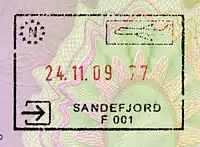 Entry stamp for air travel, issued at Sandefjord Airport in Norway.
Entry stamp for air travel, issued at Sandefjord Airport in Norway.
(Note that the stamp is in a British passport, hence it was issued on special request.) Entry stamp for rail travel, issued in Nickelsdorf at the Austro-Hungarian border before Hungary joined the Schengen Area.
Entry stamp for rail travel, issued in Nickelsdorf at the Austro-Hungarian border before Hungary joined the Schengen Area.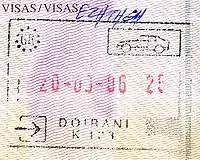 Entry stamp for road travel, issued in Doirani at the Greek-Macedonian border.
Entry stamp for road travel, issued in Doirani at the Greek-Macedonian border.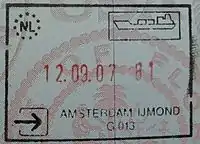 Entry stamp for ferry travel, issued at the port of Amsterdam IJmond in the Netherlands.
Entry stamp for ferry travel, issued at the port of Amsterdam IJmond in the Netherlands. Exit stamp for air travel, issued at Prague Ruzyně Airport in the Czech Republic.
Exit stamp for air travel, issued at Prague Ruzyně Airport in the Czech Republic.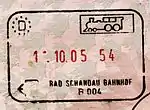 Exit stamp for rail travel, issued in Bad Schandau at the Czech-German border before the Czech Republic joined the Schengen Area.
Exit stamp for rail travel, issued in Bad Schandau at the Czech-German border before the Czech Republic joined the Schengen Area.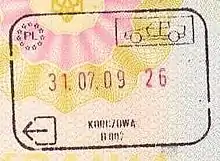 Exit stamp for road travel, issued in Korczowa at the Polish-Ukrainian border.
Exit stamp for road travel, issued in Korczowa at the Polish-Ukrainian border.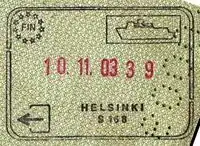
| Passport stamps by Schengen member state | ||||||||||||||||||||||||||||||||||||||||||||||||||
|---|---|---|---|---|---|---|---|---|---|---|---|---|---|---|---|---|---|---|---|---|---|---|---|---|---|---|---|---|---|---|---|---|---|---|---|---|---|---|---|---|---|---|---|---|---|---|---|---|---|---|
|
Albania
Although Albania is not a European Union or Schengen Area member state, and is outside the EU freedom of movement area, it has adopted the common Schengen design for passport stamps. In addition, passports of EU/EFTA countries, Andorra, Monaco and San Marino are not stamped.[1]
 Old-style entry stamp for air travel issued at Tirana Airport.
Old-style entry stamp for air travel issued at Tirana Airport. Old-style exit stamp for ferry travel issued at the Durrës ferry terminal
Old-style exit stamp for ferry travel issued at the Durrës ferry terminal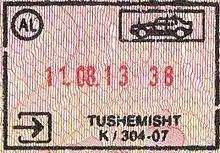 New-style entry stamp for road travel issued at Tushëmisht (border with North Macedonia)
New-style entry stamp for road travel issued at Tushëmisht (border with North Macedonia)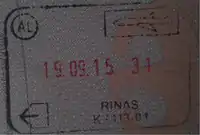 New-style exit stamp for air travel issued at Tirana Airport
New-style exit stamp for air travel issued at Tirana Airport
Andorra
Entry from France or Spain requires no formalities. However a souvenir stamp is issued on request at the border.
Belarus

Belarus is a member of the Union State of Russia and Belarus but, like Russia, still has its own passport stamps. Belarus passport stamps have the state's name in the Belorusian language: Republic of Belarus, a chevron (facing to the left for entry, to the right for exit), date and name of the checkpoint.
Bulgaria
Although Bulgaria is a European Union member state, it has not yet joined the Schengen Area. Nonetheless, it has adopted the common Schengen design for passport stamps.
 Entry stamp for air travel issued at Burgas Airport.
Entry stamp for air travel issued at Burgas Airport. Exit stamp for air travel issued at Burgas Airport.
Exit stamp for air travel issued at Burgas Airport.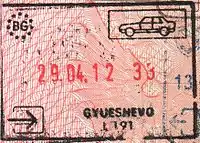 Entry stamp for road travel issued in Gyueshevo at the border with North Macedonia.
Entry stamp for road travel issued in Gyueshevo at the border with North Macedonia.
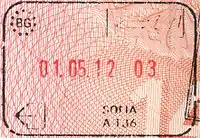 Exit stamp for air travel issued at Sofia Airport.
Exit stamp for air travel issued at Sofia Airport.
Croatia
After joining the European Union on 1 July 2013, Croatia adopted the common Schengen design for passport stamps, even though Croatia is still not a member of the Schengen passport-free area.
 Entry stamp for rail travel, issued at Savski Marof.
Entry stamp for rail travel, issued at Savski Marof.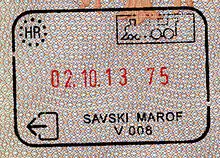 Exit stamp for rail travel, issued at Savski Marof.
Exit stamp for rail travel, issued at Savski Marof. Entry stamp for road travel, issued in Terezino Polje.
Entry stamp for road travel, issued in Terezino Polje. Exit stamp for air travel, issued at Zagreb Airport.
Exit stamp for air travel, issued at Zagreb Airport. Entry stamp for road travel at Bajakovo, issued before Croatia joined European Union
Entry stamp for road travel at Bajakovo, issued before Croatia joined European Union
Cyprus
Although Cyprus is a European Union member state, it has not yet joined the Schengen Area. Nonetheless, it has adopted the common Schengen design for passport stamps.
 Entry stamp for air travel issued at Larnaca International Airport.
Entry stamp for air travel issued at Larnaca International Airport.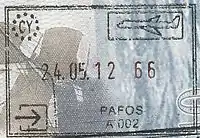 Entry stamp for air travel issued at Paphos International Airport.
Entry stamp for air travel issued at Paphos International Airport. Exit stamp for air travel issued at Paphos International Airport.
Exit stamp for air travel issued at Paphos International Airport.
Czech Republic
 Entry stamp for vehicle travel at Náchod in January 2000.
Entry stamp for vehicle travel at Náchod in January 2000.
Germany
Refused entries (Zurückweisung) are stamped in the passports, too.
 Entry at airport
Entry at airport Entry by car
Entry by car Exit by rail
Exit by rail Pre-Schengen German passport stamp
Pre-Schengen German passport stamp
Ireland
 Arrival stamp for air travel issued at Dublin Airport.
Arrival stamp for air travel issued at Dublin Airport.
Kosovo
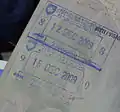 Entry and Exit stamps from Pristina International Airport Adem Jashari.
Entry and Exit stamps from Pristina International Airport Adem Jashari.
Liechtenstein
Liechtenstein is a member of the Schengen area with no borders with non-Schengen countries; thus, no passport stamps are issued. However, for a nominal fee, a souvenir stamp can be issued at the Liechtenstein Center tourist office.[49]
Lithuania
Monaco
The border with France is completely open. However, a souvenir stamp is given on request at the tourist office.
Montenegro
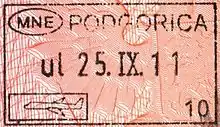 Entry stamp at Podgorica Airport
Entry stamp at Podgorica Airport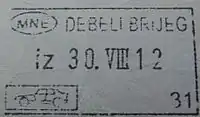 Exit stamp at Debeli Brijeg checkpoint (border with Croatia)
Exit stamp at Debeli Brijeg checkpoint (border with Croatia) Entrance stamp at Sukobin checkpoint (border with Albania)
Entrance stamp at Sukobin checkpoint (border with Albania)
North Macedonia
Although North Macedonia is not a European Union or Schengen Area member state, and is outside the EU freedom of movement area, it has adopted the common Schengen design for passport stamps. In addition, passports of EU/EFTA countries are not stamped.[2]
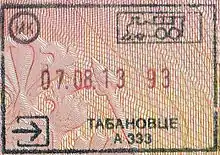 Entry stamp for rail travel at Tabanovce station (border with Serbia)
Entry stamp for rail travel at Tabanovce station (border with Serbia) Exit stamp for road travel at Dolno Blace (border with Kosovo)
Exit stamp for road travel at Dolno Blace (border with Kosovo) Entry and exit stamp for air travel at Skopje International Airport
Entry and exit stamp for air travel at Skopje International Airport
Poland
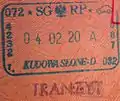 Entry for transit stamp at Kudowa-Zdrój (border with Czech Rep.), February 2000
Entry for transit stamp at Kudowa-Zdrój (border with Czech Rep.), February 2000
Romania
Romania is not currently a member of the Schengen Area, however, being in the European Union since 2007, Romanian entry and exit stamps have been harmonised with the format of the stamps issued by Schengen states.
 Entry stamp for air travel, issued at Cluj International Airport.
Entry stamp for air travel, issued at Cluj International Airport. Exit stamp for air travel, issued at Craiova International Airport.
Exit stamp for air travel, issued at Craiova International Airport.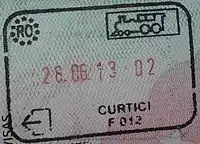 Exit stamp for train travel, issued at Curtici on the Schengen border with Hungary.
Exit stamp for train travel, issued at Curtici on the Schengen border with Hungary. Exit stamp for road travel, issued in Giurgiu on the border with Bulgaria.
Exit stamp for road travel, issued in Giurgiu on the border with Bulgaria. Entry stamp for air travel, issued at Henri Coandă International Airport.
Entry stamp for air travel, issued at Henri Coandă International Airport. Exit stamp for air travel, issued at Henri Coandă International Airport.
Exit stamp for air travel, issued at Henri Coandă International Airport. Exit stamp for air travel, issued at Iași International Airport.
Exit stamp for air travel, issued at Iași International Airport. Exit stamp for rail travel, issued in Moravița on the border with Serbia.
Exit stamp for rail travel, issued in Moravița on the border with Serbia. Entry stamp for road travel, issued in Nădlac on the border with Hungary.
Entry stamp for road travel, issued in Nădlac on the border with Hungary. Exit stamp for road travel, issued in Oancea on the border with Moldova.
Exit stamp for road travel, issued in Oancea on the border with Moldova. Entry stamp for road travel, issued in Ostrov, Constanța on the border with Bulgaria.
Entry stamp for road travel, issued in Ostrov, Constanța on the border with Bulgaria. Exit stamp for road travel, issued in Rădăuți-Prut on the border with Moldova.
Exit stamp for road travel, issued in Rădăuți-Prut on the border with Moldova. Entry stamp for road travel, issued in Sculeni on the border with Moldova.
Entry stamp for road travel, issued in Sculeni on the border with Moldova.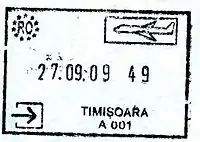 Entry stamp for air travel, issued at Timișoara Airport.
Entry stamp for air travel, issued at Timișoara Airport. Exit stamp for road travel, issued in Turnu, Arad on the border with Hungary.
Exit stamp for road travel, issued in Turnu, Arad on the border with Hungary. Exit stamp for road travel, issued in Siret on the border with Ukraine.
Exit stamp for road travel, issued in Siret on the border with Ukraine. Exit stamp for air travel, issued at Timișoara Airport shortly before the Entry of Romania in the EU.
Exit stamp for air travel, issued at Timișoara Airport shortly before the Entry of Romania in the EU.
Russia
Entry and exit stamps are placed in passports regardless of citizenship; Russian passports are stamped as well as foreign ones, except the Internal Passports, with which Russian citizens may travel to a few countries of the CIS. The stamp shows the name of the country (КПП below the country name stands for checkpoint – контрольно-пропускной пункт), the date, the name of the checkpoint and the personal code of the immigration official applying the stamp. Stamp colours and series (the last number following the date) change every time in few years, currently the colour of the stamps is red of 9 series, but it can be blue or crimson as well. Entry or exit is designated by a direction of an angle bracket in the stamp: if it points to the right, that denotes exit. Ukrainian passport stamps are identical to the Russian stamps and have the same information. They can be stamped in green, red, orange, blue, pink and sometimes black ink.
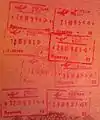 Exit (left) and entry (right) stamps at St. Petersburg Pulkovo airport (1995–1998) in a Soviet passport (Russian Federation citizenship).
Exit (left) and entry (right) stamps at St. Petersburg Pulkovo airport (1995–1998) in a Soviet passport (Russian Federation citizenship). Exit stamp for vehicle travel at Torfyanovka (border with Finland) (2005).
Exit stamp for vehicle travel at Torfyanovka (border with Finland) (2005). Exit (left) and entry stamps issued at Moscow Sheremetyevo Airport. Circled number "2" indicates travelling with a child using parent's passport (2006).
Exit (left) and entry stamps issued at Moscow Sheremetyevo Airport. Circled number "2" indicates travelling with a child using parent's passport (2006). Entry Stamp (right) and Exit Stamp (left) for boat travel issued at Saint Petersburg Port in an American passport (2006).
Entry Stamp (right) and Exit Stamp (left) for boat travel issued at Saint Petersburg Port in an American passport (2006). Exit stamp for air travel issued at Moscow Sheremetyevo Airport (2009).
Exit stamp for air travel issued at Moscow Sheremetyevo Airport (2009). New design exit stamp for air travel issued at St. Petersburg Pulkovo airport (2016).
New design exit stamp for air travel issued at St. Petersburg Pulkovo airport (2016). Right: entry stamp for rail travel issued between Vyborg and St Petersburg.
Right: entry stamp for rail travel issued between Vyborg and St Petersburg.
Left: exit stamp for rail travel issued at Aksarayskaya station.
Placed on a transit visa in a Swedish passport (2016)
San Marino
Even though there is an open border agreement with Italy, visitors can have their passport stamped by the San Marino authority at the passport office in the city centre for a small fee.
 San Marino entry stamp
San Marino entry stamp Visum 1978
Visum 1978
Serbia
Serbia stamps both Serbian and foreign passports on exit, and foreign passports also on entry (until March 2018, foreign passports were not stamped on exit).
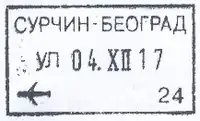 Entry stamp for air travel, issued at Belgrade Nikola Tesla Airport
Entry stamp for air travel, issued at Belgrade Nikola Tesla Airport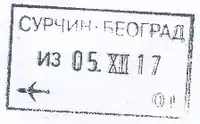 Exit stamp for air travel, issued at Belgrade Nikola Tesla Airport
Exit stamp for air travel, issued at Belgrade Nikola Tesla Airport
Switzerland
Although Switzerland is not a European Union member state, it is part of the Schengen Area and so it has adopted the common Schengen design for passport stamps.
 Entry stamp for air travel, issued at Geneva Airport before the entry of Switzerland in the Schengen zone.
Entry stamp for air travel, issued at Geneva Airport before the entry of Switzerland in the Schengen zone. Entry stamp for air travel, issued at Zurich Airport after the entry of Switzerland in the Schengen zone.
Entry stamp for air travel, issued at Zurich Airport after the entry of Switzerland in the Schengen zone.
Turkey
Although Turkey is neither a European Union member state, nor a part of the Schengen Area, it has adopted a design for passport stamps similar to that of the Schengen area.
 Entry stamp from Sabiha Gökçen Airport
Entry stamp from Sabiha Gökçen Airport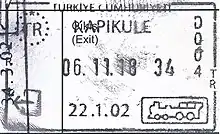 Exit stamp from Kapıkule railway station (border with Bulgaria)
Exit stamp from Kapıkule railway station (border with Bulgaria) Entry stamp from Kapıkule (border with Bulgaria)
Entry stamp from Kapıkule (border with Bulgaria)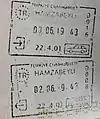 Entry and exit stamps from Hamzabeyli (border with Bulgaria)
Entry and exit stamps from Hamzabeyli (border with Bulgaria) Entry stamp from Habur (border with Iraq)
Entry stamp from Habur (border with Iraq) Exit stamp from Habur (border with Iraq)
Exit stamp from Habur (border with Iraq) Exit stamp from Pazarkule (border with Greece)
Exit stamp from Pazarkule (border with Greece)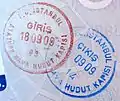 Old entry and exit stamps from Istanbul Atatürk Airport
Old entry and exit stamps from Istanbul Atatürk Airport Entry stamp at Istanbul Airport
Entry stamp at Istanbul Airport
Ukraine
Ukrainian passport stamps bear the country's name (since 2020 only country code UA), mode of travel (ship, train, vehicle, plane), code of the immigration officer, chevron (facing to the right for entry, to the left for exit), date, serial code (probably periodic), name of the checkpoint and its code. All are written in the Ukrainian language.
 Entry stamp from Mohyliv-Podilskyi checkpoint (border with Moldova) (2020)
Entry stamp from Mohyliv-Podilskyi checkpoint (border with Moldova) (2020) Exit stamp from the Bronnytsia checkpoint (border with Moldova) (2020)
Exit stamp from the Bronnytsia checkpoint (border with Moldova) (2020) Entry stamp from Kyiv Boryspil international airport in an Israeli passport (2015)
Entry stamp from Kyiv Boryspil international airport in an Israeli passport (2015) Entry stamp from Odessa international airport in an old Israeli passport (2013)
Entry stamp from Odessa international airport in an old Israeli passport (2013)
 Exit stamp from the Bolgan checkpoint (border with Moldova) (2009)
Exit stamp from the Bolgan checkpoint (border with Moldova) (2009) Exit stamp from the Krakovets checkpoint (old style) in a Kazakh passport (1999)
Exit stamp from the Krakovets checkpoint (old style) in a Kazakh passport (1999)
United Kingdom
The UK Border Force only stamps the travel documents of travellers entering the UK from outside the Common Travel Area who do not have the right of abode in the UK. When such travellers are granted leave to enter the UK, a stamp will generally be endorsed in their travel document, as the general rule laid down by section 4(1) of the Immigration Act 1971 is that power to give leave to enter the UK 'shall be exercised by notice in writing'.[50] Passport stamps are in black ink and bear the name of the entry point, as well as the immigration officer's identification number.
Non-visa nationals entering as a visitor (except Australian, Canadian, Japanese, New Zealand, Singaporean, South Korean and United States citizens)[51] receive a passport stamp with the endorsement 'Leave to enter for six months: employment and recourse to public funds prohibited'.
EU, EEA and Swiss citizens (regardless of whether they hold settled or pre-settled status under the EU Settlement Scheme in the UK) entering the UK on their passport or national identity card do not receive a stamp.[52]
If the traveller is the holder of a visa/entry clearance or a person exempt from immigration control (e.g. a diplomat), he/she receives an open date passport stamp (i.e. a stamp that does not contain any leave conditions).[53][54] Moreover, this entry passport stamp is stamped on the right edge of the visa/entry clearance (if the traveller has one) on the traveller's first entry to indicate that the document has been used, even if the document is valid for multiple entries.
The following table shows which travellers arriving in the UK from outside the Common Travel Area receive a passport stamp:
| Category of persons | Travel document to be stamped on arrival in the UK |
|---|---|
| British or Irish and Commonwealth citizens with the right of abode | No |
| EU, EEA and Swiss citizens (regardless of whether they hold settled or pre-settled status under the EU Settlement Scheme in the UK)[52] | No |
| Australian, Canadian, Japanese, New Zealand, Singaporean, South Korean and United States citizens using an ePassport gate or entering as a visitor[51] | No |
| Persons exempt from immigration control (e.g. diplomats)[54] | Yes (with an open date stamp) |
| All other persons not covered in a category above | Yes |
As a derogation from the general requirement to grant leave to enter the UK 'by notice in writing' in the form of a passport stamp (where a person without the right of abode and the right to free movement arrives in the UK from outside the Common Travel Area), UK Border Force officers are permitted by law to grant leave to enter by fax or e-mail, and may also grant leave to enter orally (including by telephone) if the traveller seeks to enter the UK as a visitor for up to 6 months.[55]
All travellers from outside the Common Travel Area entering the UK using the ePassport gates (including those without the right of abode) do not receive a passport stamp.[56] Non-visa nationals entering the UK as a visitor who successfully use an ePassport gate are granted 6 months' leave to enter (subject to conditions prohibiting employment and recourse to public funds) without receiving any written notice/endorsement.[57][58][59]
Since 20 May 2019, Australian, Canadian, Japanese, New Zealand, Singaporean, South Korean and United States citizens who enter the UK as a visitor and are granted leave to enter for 6 months do not receive a passport stamp, regardless of whether they use an ePassport gate or a staffed counter.[51] However, citizens of these countries who enter the UK with a Tier 5 (Temporary Worker – Creative and Sporting) Certificate of Sponsorship (for up to 3 months)[60] or on a permitted paid engagement[61] are not eligible to use the ePassport gates and must use a staffed counter, where they will receive a passport stamp.[62][63]
When the transition period of the UK's withdrawal from the EU came to an end on 31 December 2020, EU, EEA and Swiss citizens became subject to immigration control. However, regardless of whether they hold settled or pre-settled status under the EU Settlement Scheme in the UK, EU, EEA and Swiss citizens continue not to receive a stamp when entering the UK on their passport or national identity card.[52]
In the case of general aviation flights arriving in the UK from outside the Common Travel Area, travellers may not be inspected by the UK Border Force on arrival (depending on the risk assessment conducted on the basis of the travellers' information submitted in advance via the General Aviation Report (GAR) form) and may be 'remotely cleared' instead. In this case, no passport stamp is received.[64]
Previously, all travellers entering the UK using the Iris Recognition Immigration System (including non-UK/EU/EEA/Swiss citizens) did not receive a passport stamp.
The UK Border Agency had a policy from 23 June 2008 until 4 November 2011 of conducting onboard clearance of some passengers travelling by coach at the juxtaposed controls at the Port of Calais and the Eurotunnel Calais Terminal. Passengers' travel documents were visually inspected by a UKBA officer on the coach, without the passengers having to disembark and pass through immigration control (where their travel documents would be scanned and, when required, stamped). This concession mainly applied to school groups travelling within the European Economic Area, though it was also extended to some other groups, such as elderly passengers, travellers with special needs, brownie and scout groups and sports teams. This policy meant that some passengers whose travel documents would usually be stamped did not receive a stamp on entering the UK.[65]
Travellers arriving in the UK directly from the Channel Islands, Ireland and the Isle of Man are not subject to immigration checks as they are travelling within the Common Travel Area. Accordingly, no passport stamp is received.[66]
There are no routine exit checks when departing from the UK for a destination outside the Common Travel Area by air, rail or sea. Instead, airline/rail/ferry companies obtain passengers' travel document information at check-in or on departure and transmit the information electronically to the UK Border Force. However, from time to time spot checks are carried out by the UK Border Force (in this case, travel documents are not stamped).[67]
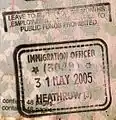 Passport stamp with 6 months' leave to enter issued at Heathrow Airport to a non-visa national.
Passport stamp with 6 months' leave to enter issued at Heathrow Airport to a non-visa national.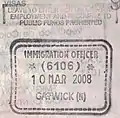 Passport stamp with 6 months' leave to enter issued at Gatwick Airport (North Terminal) to a non-visa national.
Passport stamp with 6 months' leave to enter issued at Gatwick Airport (North Terminal) to a non-visa national.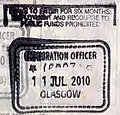 Passport stamp with 6 months' leave to enter issued at Glasgow International Airport to a non-visa national.
Passport stamp with 6 months' leave to enter issued at Glasgow International Airport to a non-visa national. Passport stamp with 6 months' leave to enter issued at the Channel Tunnel to a non-visa national.
Passport stamp with 6 months' leave to enter issued at the Channel Tunnel to a non-visa national.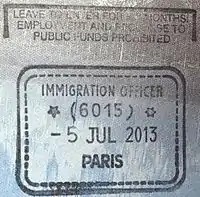 Passport stamp with 6 months' leave to enter issued at the juxtaposed controls at Paris Gare du Nord to a non-visa national.
Passport stamp with 6 months' leave to enter issued at the juxtaposed controls at Paris Gare du Nord to a non-visa national.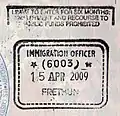 Passport stamp with 6 months' leave to enter issued at the juxtaposed controls at Calais-Fréthun station to a non-visa national.
Passport stamp with 6 months' leave to enter issued at the juxtaposed controls at Calais-Fréthun station to a non-visa national. Passport stamp with 6 months' leave to enter issued at the juxtaposed controls at the Port of Calais to a non-visa national.
Passport stamp with 6 months' leave to enter issued at the juxtaposed controls at the Port of Calais to a non-visa national.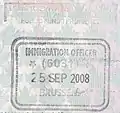 Passport stamp with 6 months' leave to enter issued at the juxtaposed controls at the Brussels-South railway station to a non-visa national.
Passport stamp with 6 months' leave to enter issued at the juxtaposed controls at the Brussels-South railway station to a non-visa national.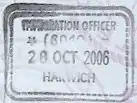 Passport stamp issued at Harwich International Port.
Passport stamp issued at Harwich International Port.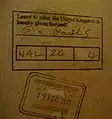 Passport stamp with 6 months' leave to enter issued at Heathrow Airport in London to a visa national from Russia. No restrictions, thus, allowed to work.
Passport stamp with 6 months' leave to enter issued at Heathrow Airport in London to a visa national from Russia. No restrictions, thus, allowed to work. Old style passport stamp issued at Durham Tees Valley Airport to a non-visa national with leave conditions laid out.
Old style passport stamp issued at Durham Tees Valley Airport to a non-visa national with leave conditions laid out.
Canada
Canada no longer routinely stamp passports upon entry. With effect from 2 April 2012, Border Services Officers of the Canada Border Services Agency will only stamp passports in the following circumstances:[68]
- Seasonal agricultural workers
- Persons authorized to extend their stay in Canada
- Visitors arriving under a Parent/Grandparent super-visa
- Persons attaining permanent resident status at a port of entry
- Diplomatic visitors accredited to Canada arriving for the first time
- Persons issued a visitor record, limiting the duration of stay in Canada
- At the specific request of the traveler arriving at an international airport equipped with a Primary Inspection Kiosk [69]
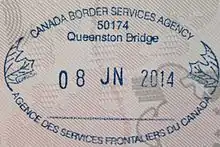 Entry stamp at Lewiston–Queenston Bridge, Ontario.
Entry stamp at Lewiston–Queenston Bridge, Ontario. Entry stamp at Montréal-Pierre Elliott Trudeau International Airport.
Entry stamp at Montréal-Pierre Elliott Trudeau International Airport. Entry stamp at Rainbow Bridge, Ontario on a Colombian passport.
Entry stamp at Rainbow Bridge, Ontario on a Colombian passport.
 Entry Stamp issued by Canada Immigration at Toronto-Lester B. Pearson International Airport This stamp was used by immigration officers for passengers who need secondary immigration checks.
Entry Stamp issued by Canada Immigration at Toronto-Lester B. Pearson International Airport This stamp was used by immigration officers for passengers who need secondary immigration checks. Entry stamp at Dorval International Airport in Montreal, which is Pierre Elliott Trudeau's airport former name. This stamp was used by passport control officers at Canada's international airports.
Entry stamp at Dorval International Airport in Montreal, which is Pierre Elliott Trudeau's airport former name. This stamp was used by passport control officers at Canada's international airports.
Cayman Islands
 Entry stamp.
Entry stamp.
Cuba
- Cuban Government by policy does not stamp US Passports.
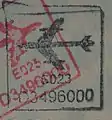 Entry and Exit stamps from Cayo Coco Airport.
Entry and Exit stamps from Cayo Coco Airport.
French overseas departments and collectivities
When arriving in and departing from the French overseas departments of Guadeloupe and Martinique and the French overseas collectivities of Saint Barthélemy, Saint Martin and Saint Pierre and Miquelon, French Border Police officers stamp travellers' travel documents according to the following rules:[10][70]
| Persons whose travel documents are to be stamped | Persons whose travel documents are not to be stamped |
|---|---|
|
|
Travellers flying directly from metropolitan France to Guadeloupe, Martinique or Saint Pierre and Miquelon only undergo border checks by the French Border Police at the departure airport in metropolitan France and not on arrival in the French overseas department/collectivity. However, as third-country nationals (who do not benefit from one of the exemptions in the right-hand column above) are required to receive a passport stamp, the French Border Police will give them an information sheet when they leave metropolitan France informing them that they should present themselves to the French Border Police at the arrival airport to receive a passport stamp. On the other hand, travellers flying directly from Guadeloupe, Martinique or Saint Pierre and Miquelon to metropolitan France undergo border checks by the French Border Police both on departure and on arrival, when their travel documents will be stamped accordingly.[11]
Whilst the rules for stamping travel documents of travellers arriving in and departing from the French overseas departments/collectivities mentioned above are based upon the rules which apply in metropolitan France and the Schengen Area (see the section above), important differences exist between the two sets of rules. For example, when crossing the external border of the Schengen Area, only family members of EU/EEA/Swiss citizens who hold a residence card issued under Article 10 of Directive 2004/38/EC and who are accompanying or joining their EU, EEA and Swiss citizen family member exercising the right of freedom of movement are exempt from having their travel documents stamped, whereas in the French overseas departments/collectivities mentioned above, more generous rules apply — when entering/leaving Guadeloupe/Martinique/Saint Pierre and Miquelon, a family member of an EU/EEA/Swiss citizen who holds a residence card issued by an EU/EEA member state or Switzerland under Article 10 of Directive 2004/38/EC is exempt from having his/her travel document stamped regardless of whether he/she is accompanying/joining his/her EU/EEA/Swiss citizen family member; when entering/leaving Saint Barthélemy and Saint Martin, a family member of an EU/EEA/Swiss citizen who holds a residence card issued by an EU/EEA member state or Switzerland is exempt from having his/her travel document stamped regardless of whether he/she is accompanying/joining his/her EU/EEA/Swiss citizen family member and regardless of whether the residence card was issued under Article 10 of Directive 2004/38/EC. Another example relates to third-country nationals who hold a residence permit issued by a Schengen member state — when crossing the external border of the Schengen Area, his/her travel document should not be stamped,[26] but when entering/leaving a French overseas department/collectivity, whilst he/she is not required to hold a visa for a short stay not exceeding 90 days in a 180-day period,[71] his/her travel document will be stamped upon entry and exit.
Another exception applies in the case of the French overseas collectivity of Saint Martin—travellers who in principle are subject to the obligation to have their travel documents stamped but who have cleared immigration control in Sint Maarten will not have their passport stamped when they enter/leave the French side of Saint Martin.[70]
The design of passport stamps issued in the French overseas departments/collectivities differs from those issued in metropolitan France/the Schengen Area. Previously, entry stamps issued in French overseas departments/collectivities were rectangular, whilst exit stamps were hexagonal. Under the current design, both entry and exit stamps issued in French overseas departments/collectivities are hexagonal and have a similar design to Schengen Area stamps. The top left corner states Outre-Mer and F, and indicates the 3-digit INSEE code for the overseas department/collectivity where the stamp was issued (971 for Guadeloupe, 972 for Martinique, 975 for Saint Pierre and Miquelon, 978 for Saint Martin).
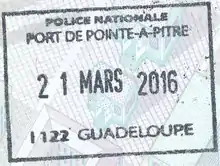 Entry stamp at the port of Pointe-à-Pitre (Guadeloupe) in a Swedish passport
Entry stamp at the port of Pointe-à-Pitre (Guadeloupe) in a Swedish passport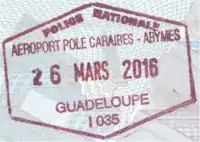 Exit stamp at Pointe-à-Pitre International Airport (Guadeloupe) in a Swedish passport
Exit stamp at Pointe-à-Pitre International Airport (Guadeloupe) in a Swedish passport Entry (top) and exit (bottom) stamps at the ferry dock in Saint-Pierre (Martinique) in a Swedish passport. As of March 2016, Saint-Pierre uses stamps from the port of Fort-de-France.
Entry (top) and exit (bottom) stamps at the ferry dock in Saint-Pierre (Martinique) in a Swedish passport. As of March 2016, Saint-Pierre uses stamps from the port of Fort-de-France.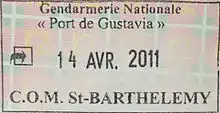 Entry stamp in Saint Barthélemy
Entry stamp in Saint Barthélemy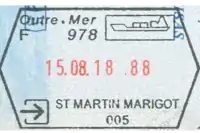 Updated Schengen style entry stamp at Marigot, Saint Martin
Updated Schengen style entry stamp at Marigot, Saint Martin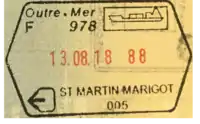 Updated Schengen style exit stamp at Marigot, Saint Martin
Updated Schengen style exit stamp at Marigot, Saint Martin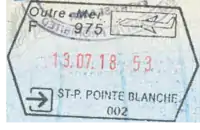 Updated Schengen style entry stamp at Saint-Pierre Airport
Updated Schengen style entry stamp at Saint-Pierre Airport Updated Schengen style exit stamp at Saint-Pierre Airport
Updated Schengen style exit stamp at Saint-Pierre Airport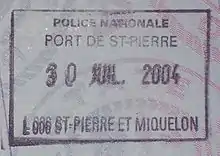 Previous style entry stamp in Saint-Pierre (Saint Pierre and Miquelon)
Previous style entry stamp in Saint-Pierre (Saint Pierre and Miquelon)
Haiti
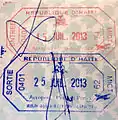 Entry and exit stamps from Toussaint Louverture International Airport, Port-au-Prince.
Entry and exit stamps from Toussaint Louverture International Airport, Port-au-Prince.
Mexico
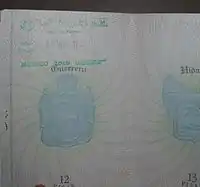 Entry stamp from Tijuana, Baja California land border crossing.
Entry stamp from Tijuana, Baja California land border crossing.
Panama
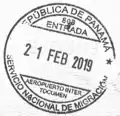 Entry stamp from Tocumen International Airport, Panamá Province.
Entry stamp from Tocumen International Airport, Panamá Province.
United States
 Entry stamp at San Francisco International Airport.
Entry stamp at San Francisco International Airport. USA stamp at Champlain–St. Bernard de Lacolle Border Crossing.
USA stamp at Champlain–St. Bernard de Lacolle Border Crossing. American stamp from John F. Kennedy International Airport in a U.S. Passport.
American stamp from John F. Kennedy International Airport in a U.S. Passport. American stamp in a U.S. Passport.
American stamp in a U.S. Passport.
The actual deadline to leave the U.S. for those admitted on a non-immigrant status is written at the bottom of the stamp, placed in the passport (when entering by air or sea) or on a green I-94W form stapled into the passport,
With the introduction of Automated Passport Control (APC), entries are not always stamped into passports of travelers using the kiosks (especially US and Canadian passports). There are custom slips printed out from the machine, which are stamped by immigration and then handed over to customs.
Australia
The Australian government no longer stamps travellers’ passports on arrival or departure from Australia as a matter of principle, regardless of whether travellers go through SmartGate or are processed manually at a counter. If travellers need exit stamps in their passports, they must ask the Australian Border Force officer when they depart from Australia.[72]
 Entry stamp at Coolangatta Airport
Entry stamp at Coolangatta Airport Exit stamp at Coolangatta Airport
Exit stamp at Coolangatta Airport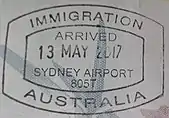 Entry stamp at Sydney Airport
Entry stamp at Sydney Airport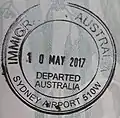 Exit stamp at Sydney Airport
Exit stamp at Sydney Airport
Fiji
 Entry stamp at Nadi International Airport in Fiji.
Entry stamp at Nadi International Airport in Fiji. Exit stamp at Nadi International Airport.
Exit stamp at Nadi International Airport.
French overseas territories (French Polynesia, New Caledonia, Wallis and Futuna)
When arriving in and departing from the French overseas territories of French Polynesia, New Caledonia and Wallis and Futuna, French Border Police officers stamp travellers' travel documents according to the following rules:[73][74][75][76]
| Persons whose travel documents are to be stamped | Persons whose travel documents are not to be stamped |
|---|---|
|
|
When travelling between the French overseas territories situated in the Pacific Ocean (for example, when travelling directly by plane from New Caledonia to French Polynesia), unless qualifying for one of the exemptions in the right hand column in the table above, a traveller will receive a passport stamp in his/her travel document upon departure from New Caledonia and another stamp upon arrival in French Polynesia.
Whilst the rules for stamping travel documents of travellers arriving in and departing from the French overseas territories in the Pacific Ocean are based upon the rules which apply in metropolitan France and the Schengen Area (see the section above), important differences exist between the two sets of rules. For example, when crossing the external border of the Schengen Area, only family members of EU/EEA/Swiss citizens who hold a residence card issued under Article 10 of Directive 2004/38/EC and who are accompanying or joining their EU, EEA and Swiss citizen family member exercising the right of freedom of movement are exempt from having their travel documents stamped, whereas in the French overseas territories in the Pacific, more generous rules apply — a family member of an EU/EEA/Swiss citizen who holds a residence permit issued by an EU/EEA member state or Switzerland is exempt from having his/her travel document stamped regardless of whether he/she is accompanying/joining his/her EU/EEA/Swiss citizen family member and regardless of whether his/her residence permit was issued under Article 10 of Directive 2004/38/EC. Another example relates to third-country nationals who hold a residence permit issued by a Schengen member state – when crossing the external border of the Schengen Area, his/her travel document should not be stamped,[26] but when entering/leaving a French overseas territory in the Pacific, whilst he/she is not required to hold a visa for a short stay not exceeding 90 days in a 180-day period,[71] his/her travel document will be stamped upon entry and exit.
The design of passport stamps issued in the French overseas territories in the Pacific differs from those issued in metropolitan France/the Schengen Area. Previously, entry stamps issued in French overseas territories in the Pacific were rectangular, whilst exit stamps were hexagonal. Under the current design, both entry and exit stamps issued in French overseas territories in the Pacific are hexagonal, and are similar in design to Schengen Area passport stamps. The top left corner states Outre-Mer and F, and indicates the 3-digit INSEE code for the overseas territory where the stamp was issued (988 for New Caledonia).
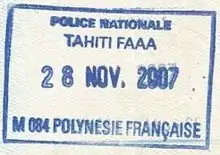 Entry stamp at Fa'a'ā International Airport in French Polynesia
Entry stamp at Fa'a'ā International Airport in French Polynesia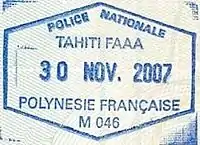 Exit stamp at Fa'a'ā International Airport in French Polynesia
Exit stamp at Fa'a'ā International Airport in French Polynesia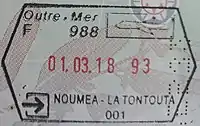 Updated Schengen style entry stamp at La Tontouta International Airport in New Caledonia
Updated Schengen style entry stamp at La Tontouta International Airport in New Caledonia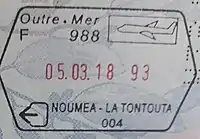 Updated Schengen style exit stamp at La Tontouta International Airport in New Caledonia
Updated Schengen style exit stamp at La Tontouta International Airport in New Caledonia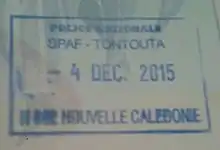 Previous style entry stamp at La Tontouta International Airport in New Caledonia
Previous style entry stamp at La Tontouta International Airport in New Caledonia Previous style exit stamp at La Tontouta International Airport in New Caledonia
Previous style exit stamp at La Tontouta International Airport in New Caledonia Older style exit stamp at La Tontouta International Airport in New Caledonia
Older style exit stamp at La Tontouta International Airport in New Caledonia
New Zealand
Since March 2018, the New Zealand Customs Service ceased stamping passports for Australian permanent residents and New Zealand residents.[77] General entry stamps continue to be used for temporary visa holders.
On arrival in New Zealand, travellers who are neither New Zealand nor Australian citizens or permanent residents who are granted entry into the country will receive a 'Visitor Visa' rectangular stamp in their travel document.
New Zealand and Australian citizens do not have their passports stamped on arrival in New Zealand unless specifically requested.
Travellers using eGate (available to holders of a New Zealand, Australian, Chinese, Canadian, Dutch, French, German, Irish, Japanese, Singaporean, South Korean, United Kingdom or United States ePassport aged 12 years or over) will not have their passports stamped on arrival in New Zealand.
For all travellers, passports are not stamped on departure from New Zealand regardless of nationality and whether using an immigration desk or eGate.
 General Entry stamp (given to temporary visa holders upon entry)
General Entry stamp (given to temporary visa holders upon entry)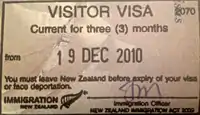 Visitors Visa Entry stamp (for all non-NZ/Australian passport holders without residency in either country)
Visitors Visa Entry stamp (for all non-NZ/Australian passport holders without residency in either country) Resident Visa Entry Stamp (no longer issued as of March 2018)
Resident Visa Entry Stamp (no longer issued as of March 2018)
Niue
Niue passport stamps bear the name of the country, a map outline of Niue, date and location of entry/departure.
.png.webp) Entry stamp at Niue International Airport
Entry stamp at Niue International Airport.png.webp) Exit stamp at Niue International Airport
Exit stamp at Niue International Airport
Vanuatu
The passport stamp bears the country name, date and port of entry/departure.
 Entry stamp at Port Vila
Entry stamp at Port Vila Exit stamp at Port Vila
Exit stamp at Port Vila
Argentina
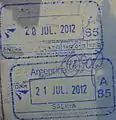 Entry and exit stamps from the Argentina-Brazil border at Puerto Iguazu. Shown here in a U.S. Passport.
Entry and exit stamps from the Argentina-Brazil border at Puerto Iguazu. Shown here in a U.S. Passport.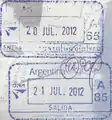
Brazil
Holder of Brazilian passports entering or departing from Brazil will not receive a passport stamp. However, other nationals will go through customs and receive a stamp for both entry and exit. When entering Brazil by car from another country such as Argentina or Paraguay, few people go through customs and thus rarely receive stamps in their passport.
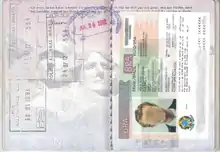 Brazilian entry and exit stamps in a US Passport, opposite from the visa. Near a French and American stamp.
Brazilian entry and exit stamps in a US Passport, opposite from the visa. Near a French and American stamp. Brazilian entry stamp in a US passport.
Brazilian entry stamp in a US passport. Brazilian exit stamp in a US passport.
Brazilian exit stamp in a US passport.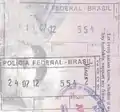 Entry and exit stamps, issued at São Paulo Airport.
Entry and exit stamps, issued at São Paulo Airport.
Chile
 Chilean entry stamp in a New Zealand passport, issued by the PDI at Santiago Airport.
Chilean entry stamp in a New Zealand passport, issued by the PDI at Santiago Airport. Chilean exit stamp in a New Zealand passport, issued by the PDI at the Paseo los Liberadores border crossing.
Chilean exit stamp in a New Zealand passport, issued by the PDI at the Paseo los Liberadores border crossing.
Colombia
 Entry stamp from El Dorado Airport
Entry stamp from El Dorado Airport Exit stamp from El Dorado Airport
Exit stamp from El Dorado Airport Exit tax exemption stamp issued by the Aeronautica Civil at El Dorado Airport
Exit tax exemption stamp issued by the Aeronautica Civil at El Dorado Airport
French Guiana
When arriving in and departing from the French overseas department of French Guiana, French Border Police officers stamp travellers' travel documents according to the following rules:[9][10]
| Persons whose travel documents are to be stamped | Persons whose travel documents are not to be stamped |
|---|---|
|
|
Travellers flying directly from metropolitan France to French Guiana only undergo border checks by the French Border Police at the departure airport in metropolitan France and not on arrival in French Guiana. However, as third-country nationals (who do not benefit from one of the exemptions in the right-hand column above) are required to receive a passport stamp, the French Border Police will give them an information sheet when they leave metropolitan France informing them that they should present themselves to the French Border Police at the arrival airport to receive a passport stamp. On the other hand, travellers flying directly from French Guiana to metropolitan France undergo border checks by the French Border Police both on departure and on arrival, when their travel documents will be stamped accordingly.[11]
Both entry and exit stamps issued in French Guiana are hexagonal, and are similar in design to Schengen Area passport stamps. The top left corner states Outre-Mer and F, and indicates the 3-digit INSEE code (973) for French Guiana.
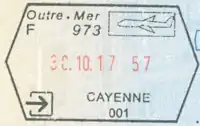 Entry stamp at Cayenne – Félix Eboué Airport
Entry stamp at Cayenne – Félix Eboué Airport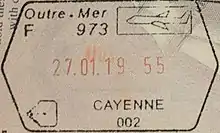 Exit stamp at Cayenne – Félix Eboué Airport
Exit stamp at Cayenne – Félix Eboué Airport
Peru
 Peruvian entry stamp in a New Zealand passport, issued at Lima Airport. Part of a UK entry stamp is visible in the top part.
Peruvian entry stamp in a New Zealand passport, issued at Lima Airport. Part of a UK entry stamp is visible in the top part. Peruvian exit stamp in a New Zealand passport, issued at Lima Airport. Part of a UK entry stamp is visible in the bottom part, as is part of a Chilean stamp in the right.
Peruvian exit stamp in a New Zealand passport, issued at Lima Airport. Part of a UK entry stamp is visible in the bottom part, as is part of a Chilean stamp in the right.
Venezuela
 Entry stamp to Santiago Mariño Intl. Airport; Margarita Island, Venezuela
Entry stamp to Santiago Mariño Intl. Airport; Margarita Island, Venezuela Exit stamp Simón Bolívar Intl. Airport; Caracas, Venezuela
Exit stamp Simón Bolívar Intl. Airport; Caracas, Venezuela
Countries/Regions not issuing exit immigration stamps
In some countries, there is no formal control by immigration officials of travel documents upon exit. Consequently, exit stamps are not placed in passports. Exit may be recorded by immigration authorities via information provided to them by carriers when the passenger departs from the country.
No exit control
 United States of America[78]
United States of America[78].svg.png.webp) Canada
Canada Mexico (by air)
Mexico (by air)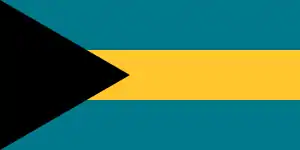 Bahamas
Bahamas Ireland
Ireland United Kingdom (Border Force officers do not carry out systematic checks of travel documents on passengers travelling to a destination outside the Common Travel Area by air, rail or sea (though from time to time spot checks are carried out – in this case passports are not stamped); instead, airline/rail/ferry companies obtain passengers' travel document information at check-in or on departure and transmit the information electronically to the UK Border Force)[67]
United Kingdom (Border Force officers do not carry out systematic checks of travel documents on passengers travelling to a destination outside the Common Travel Area by air, rail or sea (though from time to time spot checks are carried out – in this case passports are not stamped); instead, airline/rail/ferry companies obtain passengers' travel document information at check-in or on departure and transmit the information electronically to the UK Border Force)[67]
Formal exit control without passport stamping
.svg.png.webp) Australia (Exit stamp issued upon explicit request)[79]
Australia (Exit stamp issued upon explicit request)[79] China (Exit stamp issued upon request when using e-Gate)
China (Exit stamp issued upon request when using e-Gate)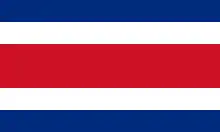 Costa Rica (only at Costa Rican airports; different entry and exit stamps are made at the border crossing with Panama)
Costa Rica (only at Costa Rican airports; different entry and exit stamps are made at the border crossing with Panama)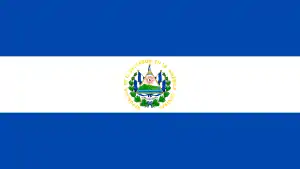 El Salvador
El Salvador Fiji
Fiji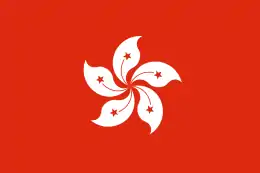 Hong Kong (no entry or exit stamps are issued, instead landing slips are issued upon arrival only)[80]
Hong Kong (no entry or exit stamps are issued, instead landing slips are issued upon arrival only)[80] Iran[81]
Iran[81] Israel (no entry or exit stamps are issued at Ben Gurion Airport, instead landing slips are issued upon arrival and departure)
Israel (no entry or exit stamps are issued at Ben Gurion Airport, instead landing slips are issued upon arrival and departure) Japan (Exit stamp issued upon request & when not using e-Gate since July 2019)[82]
Japan (Exit stamp issued upon request & when not using e-Gate since July 2019)[82]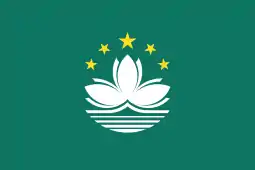 Macau (no entry or exit stamps are issued, instead landing slips are issued upon arrival only)
Macau (no entry or exit stamps are issued, instead landing slips are issued upon arrival only) New Zealand
New Zealand South Korea (since 1 November 2016)
South Korea (since 1 November 2016)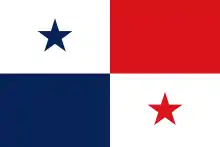 Panama (only at Panamanian airports; different entry and exit stamps are made at the border crossing with Costa Rica)
Panama (only at Panamanian airports; different entry and exit stamps are made at the border crossing with Costa Rica) Republic of China (exit stamp issued upon request & when not using e-Gate)
Republic of China (exit stamp issued upon request & when not using e-Gate) Singapore (no exit stamps since 22 April 2019)[83]
Singapore (no exit stamps since 22 April 2019)[83]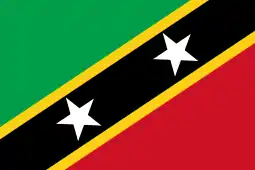 Saint Kitts and Nevis
Saint Kitts and Nevis Schengen Area countries (when the Entry Exit System becomes operational in 2022, it is anticipated that the passports of third-country nationals will not be stamped when they enter and leave the Schengen Area)[22]
Schengen Area countries (when the Entry Exit System becomes operational in 2022, it is anticipated that the passports of third-country nationals will not be stamped when they enter and leave the Schengen Area)[22]
However, in some of these countries a departure card is stamped.
See also
| Wikimedia Commons has media related to Passport stamps. |
Notes
- 5 Caribbean Ports to Get Your Passport Stamped
- Cruise Tales – 2015 South and East Caribbean #6: In Search of Passport Stamps
- Tens of thousands of hours can be saved by non-stamping immigration clearance
- "Tanjong Pagar: Talks 'break down'", New Straits Times, pp. 1, 7, 31 July 1998
- Sukyingcharoenwong, Mayuree (1 August 2017). "Singapore, HK visitors to enjoy fast immigration". The Nation. Bangkok.
- Arrêté du 4 février 2015 relatif aux documents et visas exigés pour l'entrée des étrangers sur le territoire de Mayotte
- Arrêté du 26 juillet 2011 relatif aux documents et visas exigés pour l'entrée des étrangers sur le territoire de la Guadeloupe, la Guyane, la Martinique, La Réunion et de la collectivité de Saint-Pierre-et-Miquelon (Annexe I)
- "Doubles contrôles aux frontières dans les aéroports de la capitale pour les Français des Antilles". Senate of France. 20 September 2018. Retrieved 15 March 2020.
- "EXIT STAMP – Entry into force on 1st of October 2014". 2014-09-23. Retrieved 2017-08-09.
- "Commission Staff Working Document: Impact Assessment Report on the establishment of an EU Entry Exit System, pg. 11" (PDF). 2016-04-06. Retrieved 2017-04-19.
- Proposal for a Regulation of the European Parliament and of the Council establishing an Entry/Exit System (EES) to register entry and exit data of third country nationals crossing the external borders of the Member States of the European Union, pg. 2
- Communication from the European Commission to the European Parliament and the Council: Communication from the Commission to the European Parliament and the Council, pg. 6
- Current state of play in relation to innovated border management in the EU
- Council of the European Union: Questionnaire on the possible creation of a system of electronic recording of entries and exits of third country nationals in the Schengen area
- Council of the European Union: Questionnaire on the possible creation of a system of electronic recording of entries and exits of third country nationals in the Schengen area (Replies from Bulgaria, France, Iceland, Italy, Norway and Portugal)
- Council of the European Union: Questionnaire on the possible creation of a system of electronic recording of entries and exits of third country nationals in the Schengen area (Reply from Greece)
- Communication from the Commission to the European Parliament, the Council, the European Economic and Social Committee and the Committee of the Regions – Preparing the next steps in border management in the European Union, p.5.
- Regulation (EU) 2017/2226 of the European Parliament and of the Council of 30 November 2017 establishing an Entry/Exit System (EES) to register entry and exit data and refusal of entry data of third-country nationals crossing the external borders of the Member States and determining the conditions for access to the EES for law enforcement purposes, and amending the Convention implementing the Schengen Agreement and Regulations (EC) No 767/2008 and (EU) No 1077/2011 (OJ L 327, 9 December 2017, p. 20)
- "Smart Borders". European Commission. Retrieved 12 April 2020.
- Report from the Commission to the European Parliament and the Council on the operation of the provisions on stamping of the travel documents of third-country nationals in accordance with Articles 10 and 11 of Regulation (EC) No 562/2006 (COM (2009) 489, p. 8)
- Article 11 of the Schengen Borders Code (Regulation (EU) 2016/399) (OJ L 77, 23 March 2016, pp. 1–52)
- Report from the Commission to the European Parliament and the Council on the operation of the provisions on stamping of the travel documents of third-country nationals in accordance with Articles 10 and 11 of Regulation (EC) No 562/2006 (COM (2009) 489, p. 7)
- Report from the Commission to the European Parliament and the Council on the operation of the provisions on stamping of the travel documents of third-country nationals in accordance with Articles 10 and 11 of Regulation (EC) No 562/2006 (COM (2009) 489, pp. 6 and 9) "The Commission is of the opinion that travel documents of third-country nationals who are in possession of a valid residence permit issued by a Schengen Member State should not be stamped." "The Commission underlines that travel documents of third-country nationals who are in possession of a valid residence permit of a Schengen Member State are exempted from the stamping obligation on entry and exit."
- "Brexit Readiness: treating UK nationals at the external Schengen borders and related issues" (PDF). 2020-10-12. Retrieved 2021-01-19.
- US Department of State: Schengen Fact Sheet
- Report from the Commission to the European Parliament and the Council on the operation of the provisions on stamping of the travel documents of third-country nationals in accordance with Articles 10 and 11 of Regulation (EC) No 562/2006 (COM (2009) 489, p. 4)
- Article 12 of the Schengen Borders Code (Regulation (EU) 2016/399) (OJ L 77, 23 March 2016, pp. 1–52)
- Berra, Catherine (6 March 2011). "Le directeur régional des douanes suspendu" [The regional director of customs suspended]. France 3.fr (in French). Archived from the original on 6 June 2011.
- "West Wing Week: Mailbag Day Summer Edition". West Wing Week. 13 August 2010. Event occurs at 1:49.
- "Quel titre de séjour faut-il avoir pour rester en France plus de 3 mois ? | service-public.fr".
- Practical Handbook for Border Guards, Part II, Section I, Point 6.1 (C (2019) 7131, 8 October 2019, p. 56)
- Annex IV of the Schengen Borders Code (Regulation (EU) 2016/399) (OJ L 77, 23 March 2016, pp. 1–52)
- Annex II of the Schengen Borders Code (Regulation (EU) 2016/399) (OJ L 77, 23 March 2016, pp. 1–52)
- "Schengen Catalogue: External borders control recommendations and best practices" (PDF). Archived from the original (PDF) on 2015-07-02. Retrieved 2012-07-29.
- Practical Handbook for Border Guards, Part II, Section I, Point 6.5 (C (2019) 7131, 8 October 2019, p. 58)
- Annex V of the Schengen Borders Code (Regulation (EU) 2016/399) (OJ L 77, 23 March 2016, pp. 1–52)
- Practical Handbook for Border Guards, Part II, Section I, Point 8.4 (C (2019) 7131, 8 October 2019, p. 68)
- Practical Handbook for Border Guards, Part II, Section I, Point 8.6 (C (2019) 7131, 8 October 2019, pp. 68-69)
- COVID-19: Temporary Restriction on Non-Essential Travel to the EU (COM (2020) 115, 16 March 2020)
- "Temporary non-essential travel restrictions". European Commission.
- Guidance on the implementation of the temporary restriction on non-essential travel to the EU, on the facilitation of transit arrangements for the repatriation of EU citizens, and on the effects on visa policy' in order to provide 'advice and practical instructions (C (2020) 2050, 30 March 2020)
- "How To Use The Automated Border Control Gates" (PDF). Finnair Info. Archived from the original (PDF) on 2012-10-18. Retrieved 2012-07-20.
- http://www.raja.fi/facts/news_from_the_border_guard/1/0/expanded_use_of_automated_border_control_gates_at_the_west_terminal_54569
- http://frontex.europa.eu/assets/Images_News/ABC_Conference_Report.pdf
- Art 11(3) of the Schengen Borders Code (Regulation (EU) 2016/399) recognises that an entry or exit stamp may be recorded on a sheet of paper indicating the traveller's name and travel document number (rather than inside the traveller's travel document) where stamping the travel document would cause 'serious difficulties' for the traveller. It could be argued that at a particular border crossing point the state of facilities are such that to deny travellers subject to the stamping obligation access to automated border gates and to require them to be processed manually by border guards would constitute 'serious difficulties' for such persons.
- Liechtenstein Center
- Immigration Act 1971, section 4(1)
- "A short guide on right to rent" (PDF). Home Office. July 2019. p. 8.
Since 20 May 2019, the majority of individuals from Australia, Canada, Japan, New Zealand, Singapore, South Korea and the USA (known as B5JSSK nationals) have been able to use the eGates at UK airports, sea ports and Brussels and Paris Eurostar terminals, to enter the UK. Those individuals wishing to do so must hold a biometric passport. Those individuals not in possession of a biometric passport will be processed by a Border Force Officer at the manned passport control point. They will not have their passports endorsed with a stamp, instead individuals will be informed of their leave and its associated conditions orally by a Border Force Officer.
- "Visit guidance" (PDF). Home Office. 1 December 2020. pp. 74–75.
Nationals of Australia, Canada, Japan, New Zealand, Singapore, South Korea, and the United States of America (B5JSSK), EEA states and Switzerland are able to use ePassport gates to enter the UK. If they do so without holding a valid entry clearance, they will automatically receive 6 months permission to enter as a standard visitor and will not receive an endorsement in their passport. If granting permission to enter as a standard visitor to a B5JSSK, EEA or Swiss national at the staffed primary control point, you should not endorse the passenger’s travel document with a code 5N but should instead grant permission to enter verbally, in line with the B5JSSK guidance.
- "UK Border Force Operations Manual: EEA Nationals & their family members (General Guidance)" (PDF). Archived from the original (PDF) on 15 April 2013. Retrieved 26 July 2012.
- "UK Border Force Operations Manual: Persons exempt from control" (PDF). Archived from the original (PDF) on 15 April 2013. Retrieved 26 July 2012.
- The Immigration (Leave to Enter and Remain) Order 2000, Articles 8 and 8ZA (as amended by "The Immigration (Leave to Enter and Remain) (Amendment) Order 2013", legislation.gov.uk, The National Archives, SI 2013/1749)
- "Entering the UK: At border control". UK Border Force.
You cannot get a stamp if you use the ePassport gates.
- The Immigration (Leave to Enter and Remain) Order 2000, Article 8B (as amended by "The Immigration (Leave to Enter and Remain) (Amendment) Order 2019", legislation.gov.uk, The National Archives, SI 2019/298)
- "Visit guidance" (PDF). Home Office. 22 August 2019. pp. 67–68.
- The Immigration (Leave to Enter and Remain) Order 2000, Articles 8(5) and 8A (as amended by "The Immigration (Leave to Enter and Remain) (Amendment) Order 2010", legislation.gov.uk, The National Archives, SI 2010/957)
- "Temporary Worker – Creative and Sporting visa (Tier 5)". Gov.uk.
- "Visit guidance" (PDF). Home Office. 22 August 2019. p. 58.
- "Entering the UK". Gov.uk.
- "Guide to faster travel through the UK border". UK Border Force. 20 May 2019.
- "An inspection of General Aviation and General Maritime (February – July 2015)" (PDF). Independent Chief Inspector of Borders and Immigration. January 2016. pp. 15–27.
- "An investigation into border security checks" (PDF). Independent Chief Inspector of Borders and Immigration. February 2012. pp. 26–28 and 78.
- "Common Travel Area" (PDF). Home Office. 22 October 2019.
- "Exit checks fact sheet". Border Force and Home Office. 29 March 2015.
- ENF 4 Port of Entry Examinations
- Primary Inspection Kiosks
- Arrêté du 18 avril 2012 relatif aux documents et visas exigés pour l'entrée des étrangers sur le territoire des collectivités de Saint-Barthélemy et de Saint-Martin (Annexe I)
- "Requesting a visa".
- "Departing from Australia". Australian Government Department of Home Affairs. Archived from the original on 29 July 2018. Retrieved 29 July 2018.
We no longer stamp Australian passports as a matter of course but should you require evidence of travel you may ask one of our officers to do so.
- Arrêté du 29 décembre 2011 relatif aux documents et visas exigés pour l'entrée des étrangers sur le territoire de la Polynésie française (Annexe I)
- "Direction de la Police Aux Frontières / Sécurité / Services de l'État / Accueil – les services de l'État en Polynesie française".
- Arrêté du 22 juillet 2011 relatif aux documents et visas exigés pour l'entrée des étrangers sur le territoire de la Nouvelle-Calédonie (Annexe I)
- Arrêté du 26 juillet 2011 relatif aux documents et visas exigés pour l'entrée des étrangers sur le territoire des îles Wallis et Futuna (Annexe I)
- "Removal of passport stamps for New Zealand and Australian residents". Immigration New Zealand. 23 March 2018. Retrieved 3 April 2020.
- "Arrival/Departure Forms: I-94 and I-94W | U.S. Customs and Border Protection". www.cbp.gov. Retrieved 2020-01-10.
- "At the Border". Australian Border Force. Australian Government. 11 November 2018. Retrieved 10 January 2020.
- "Non-stamping Immigration Clearance Arrangement | Immigration Department". www.immd.gov.hk. Retrieved 2020-01-10.
- "No more passport stamps for foreign nationals visiting Iran". Tehran Times. 2019-06-24. Retrieved 2020-01-10.
- "departing or arriving". japantimes. Japan Times. Retrieved 2 July 2017.
- "Foreigners leaving Singapore will no longer have their passports stamped". CNA. Retrieved 2020-01-10.
References
- Report from the Commission to the European Parliament and the Council on the operation of the provisions on stamping of the travel documents of third-country nationals in accordance with Articles 10 and 11 of Regulation (EC) No 562/2006 establishing a Community Code on the rules governing the movement of persons across borders (Schengen Borders Code). European Commission. 2009. Retrieved 2012-06-26.
- Regulation (EC) No 562/2006 of the European Parliament and of the Council of 15 March 2006 establishing a Community Code on the rules governing the movement of persons across borders (Schengen Borders Code)
External links
- PassportStamp A site for recording passport stamp visits
- Passport stamps from the whole world – 181 countries, 748 scans
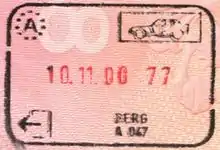

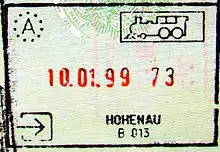



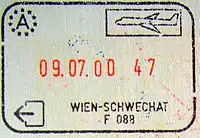


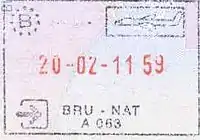

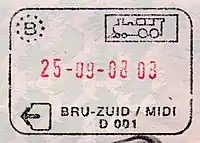
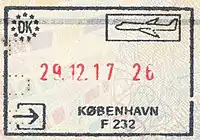
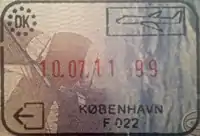

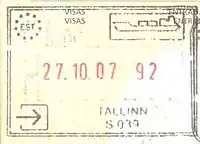

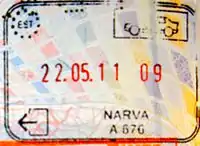
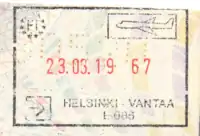





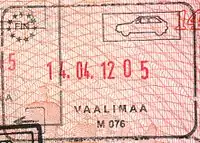
























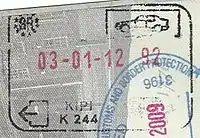

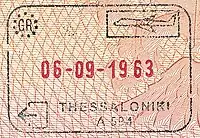


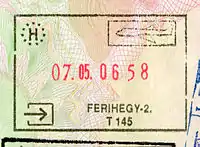


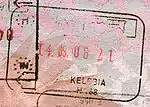

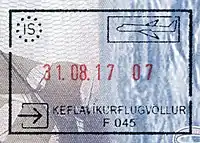
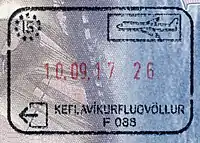

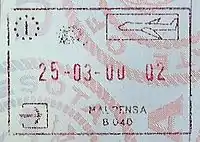




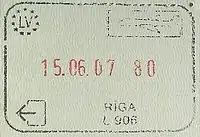

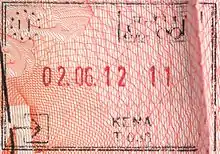

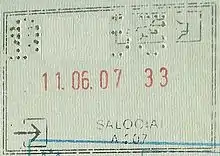
.jpg.webp)
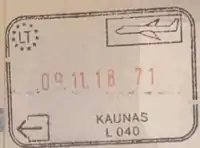

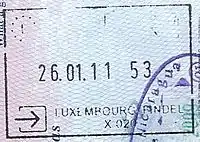
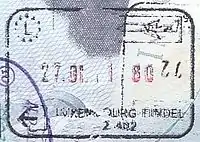
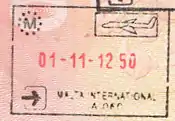
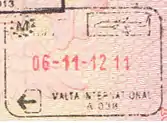

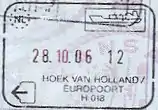

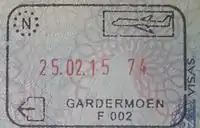
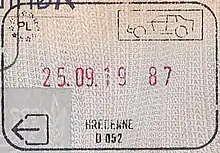



.jpg.webp)

